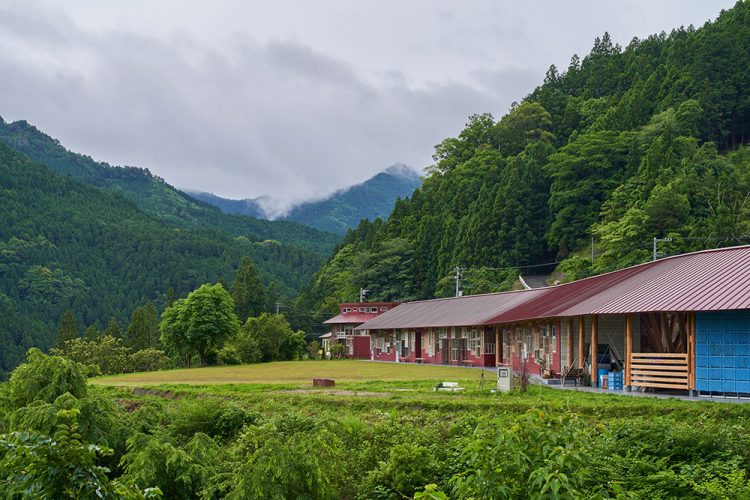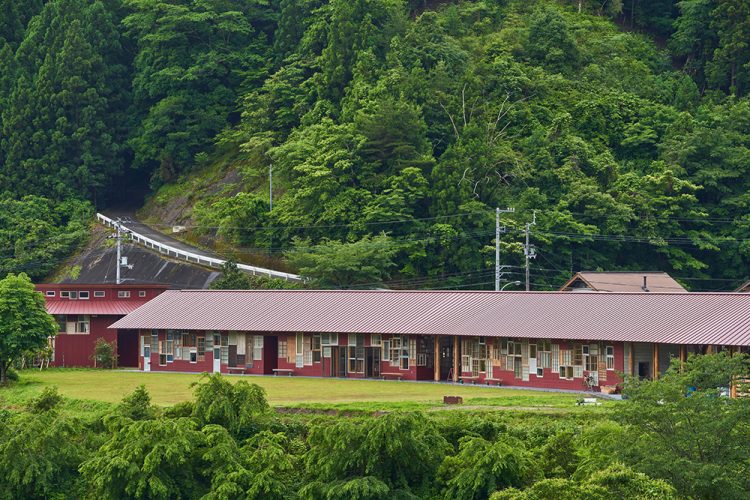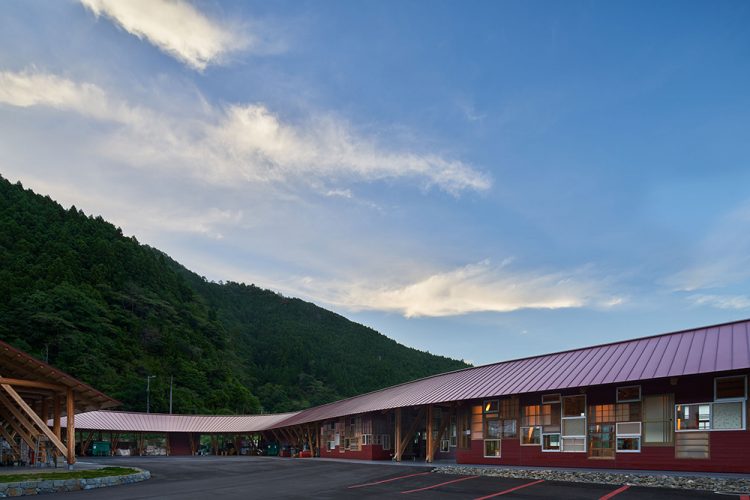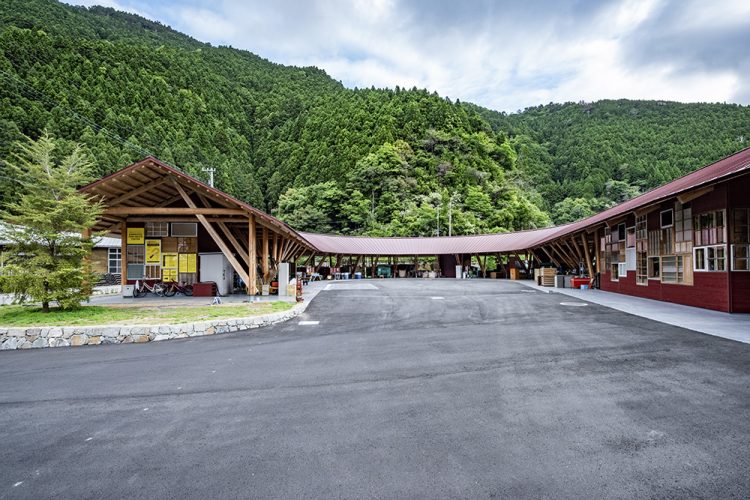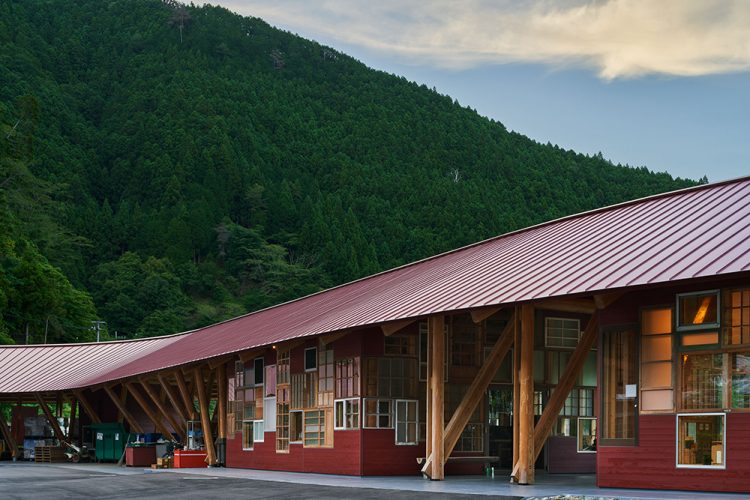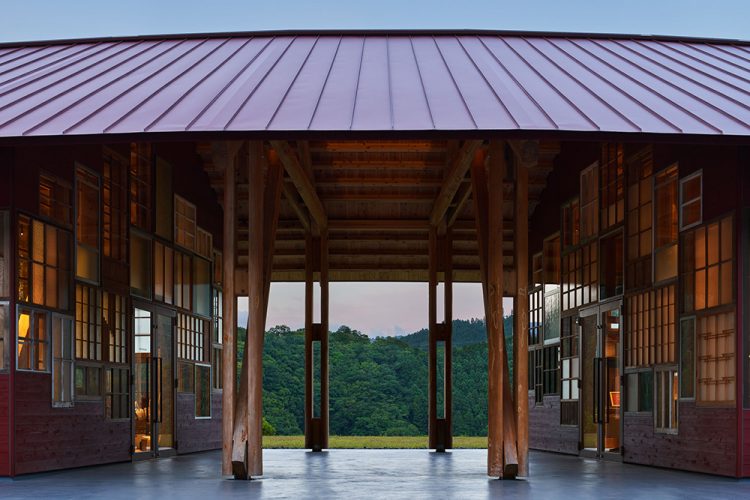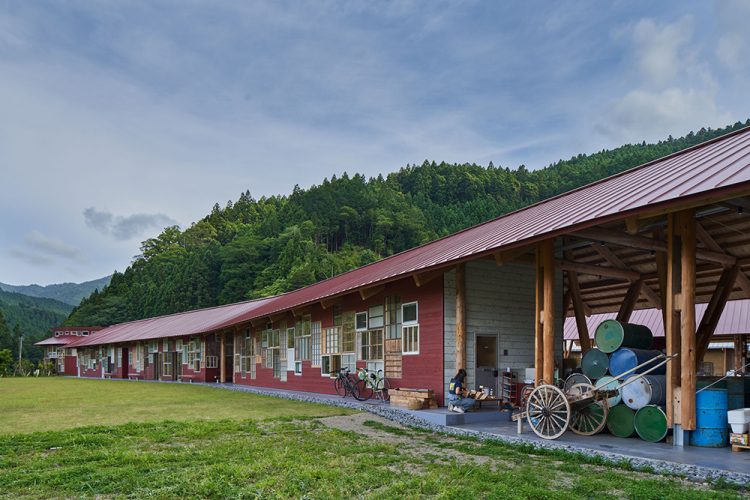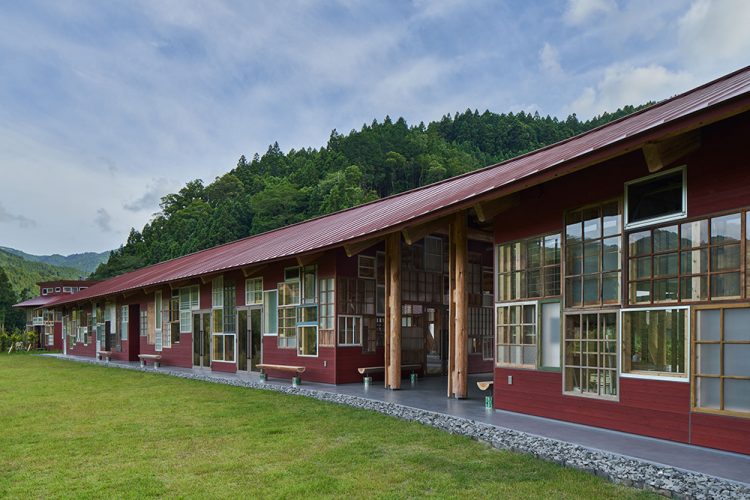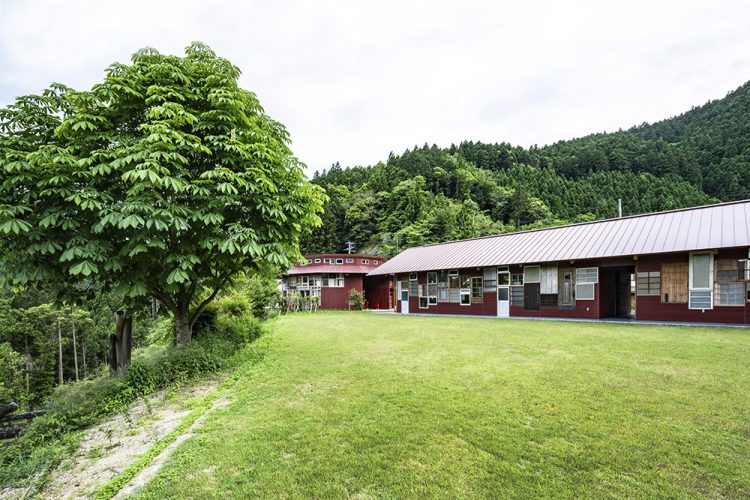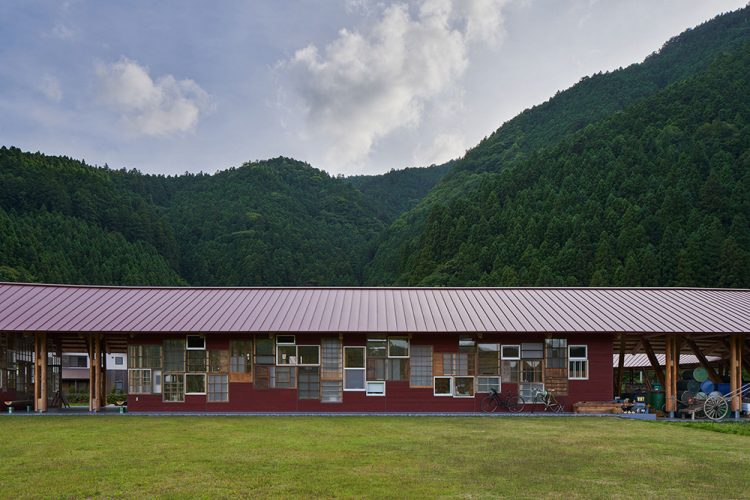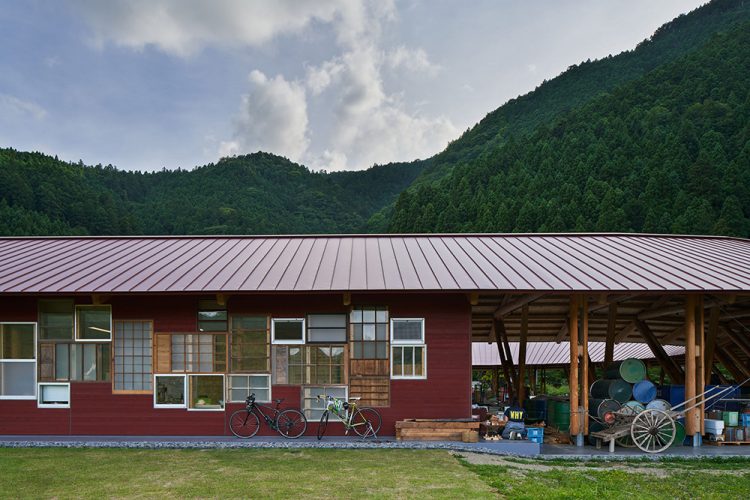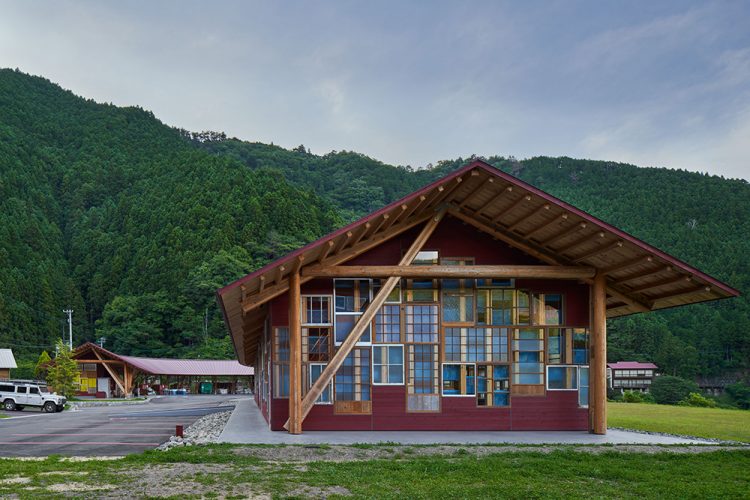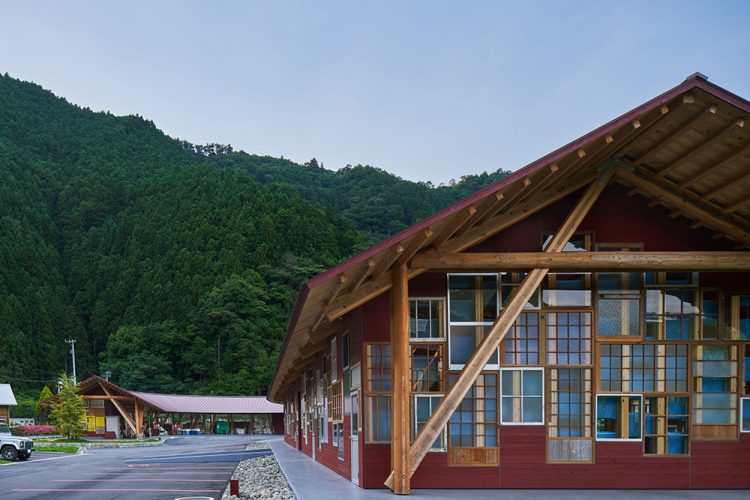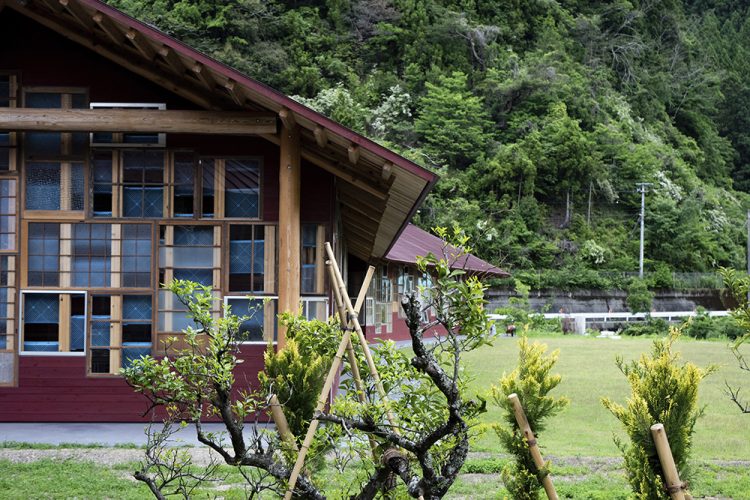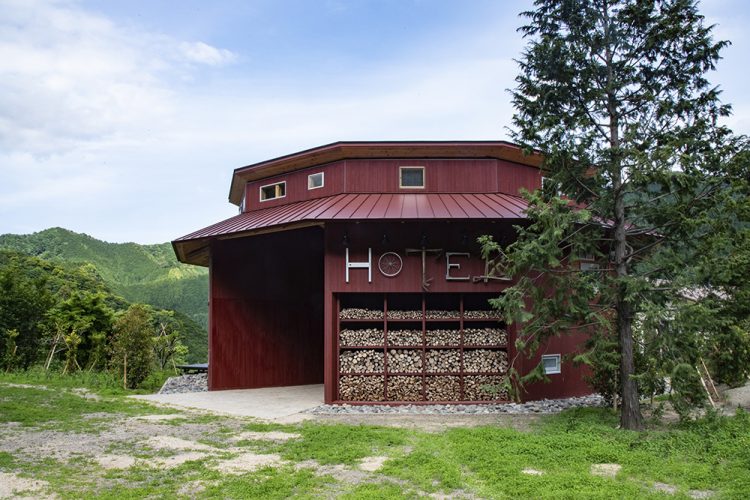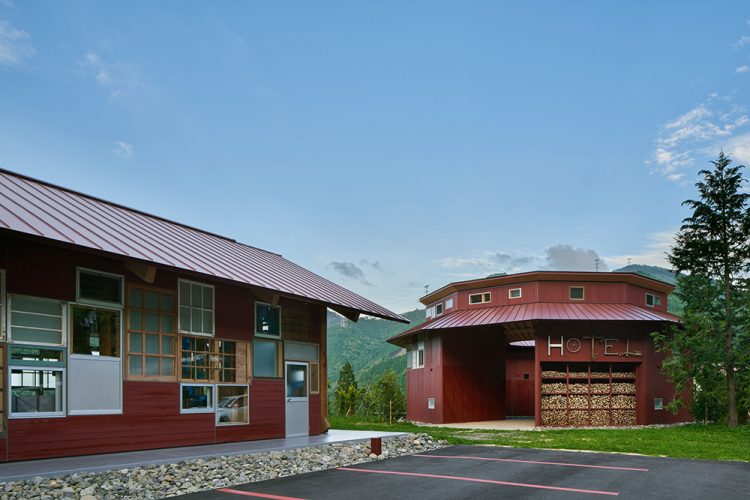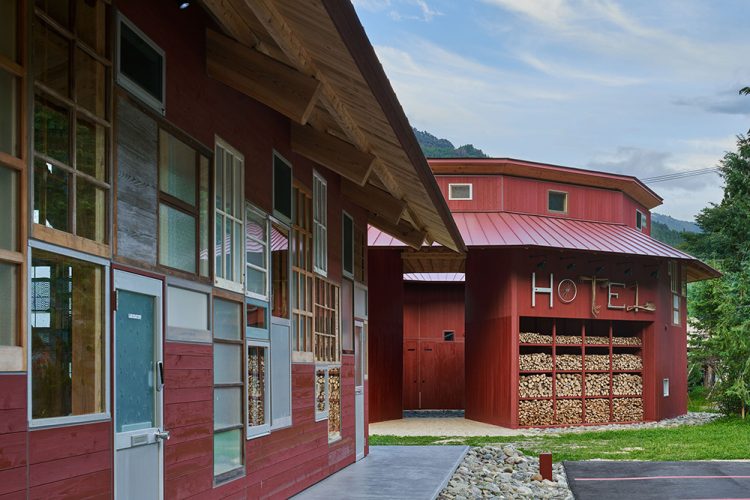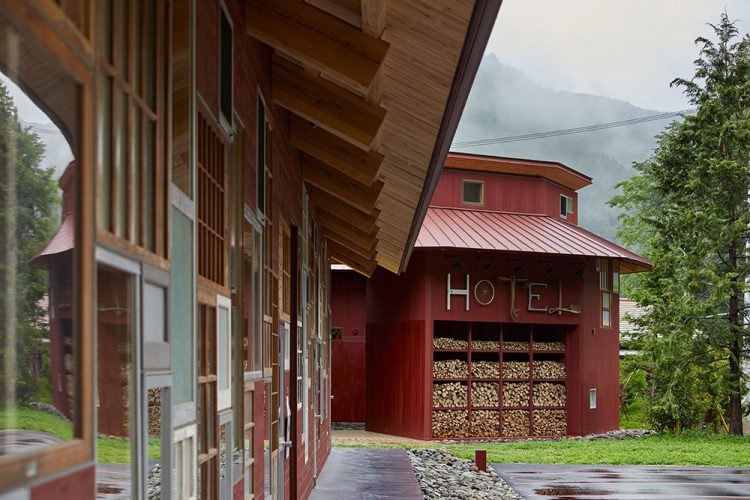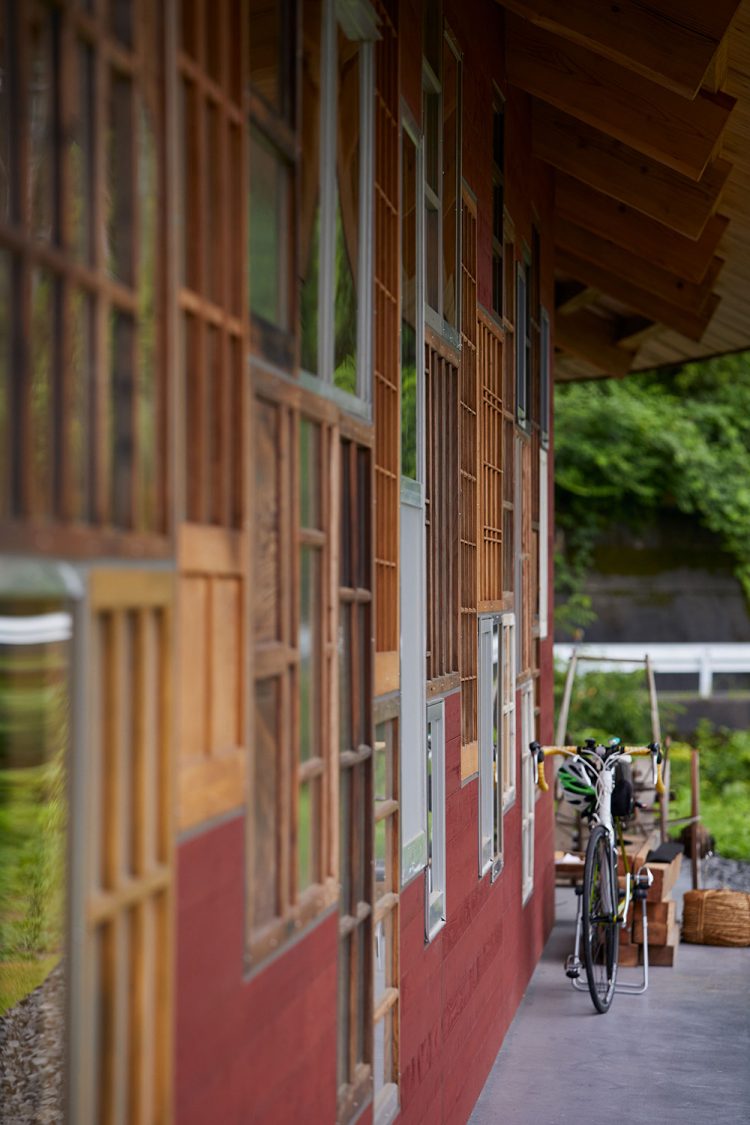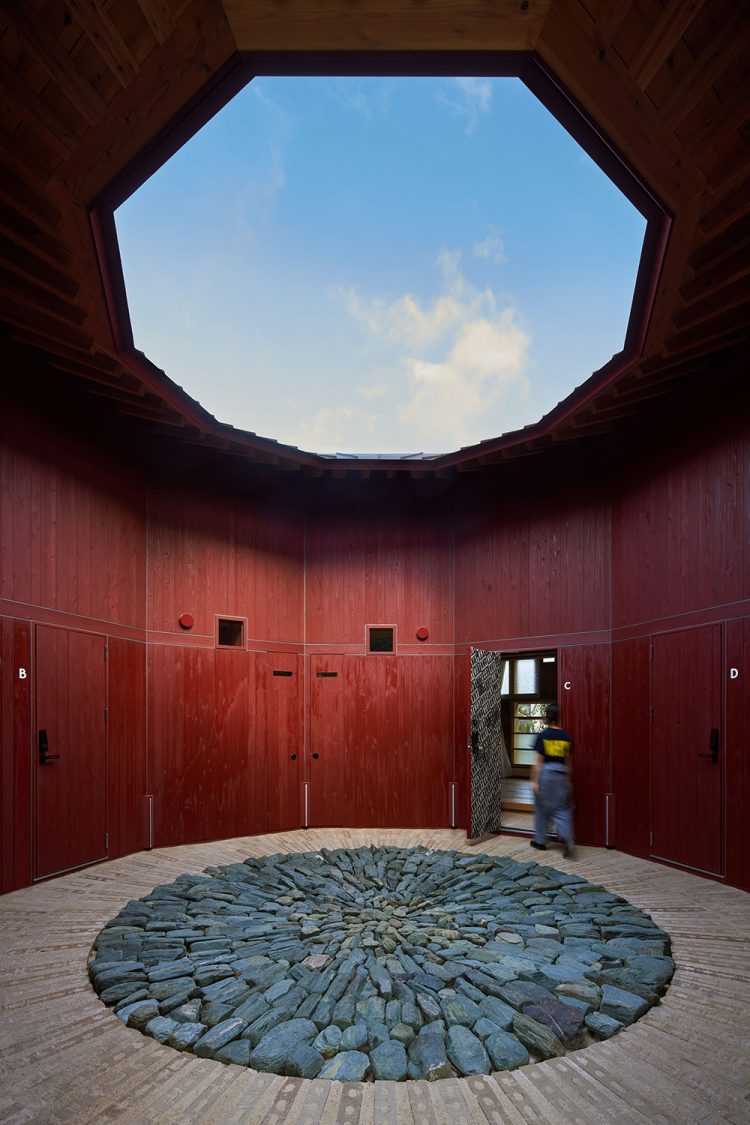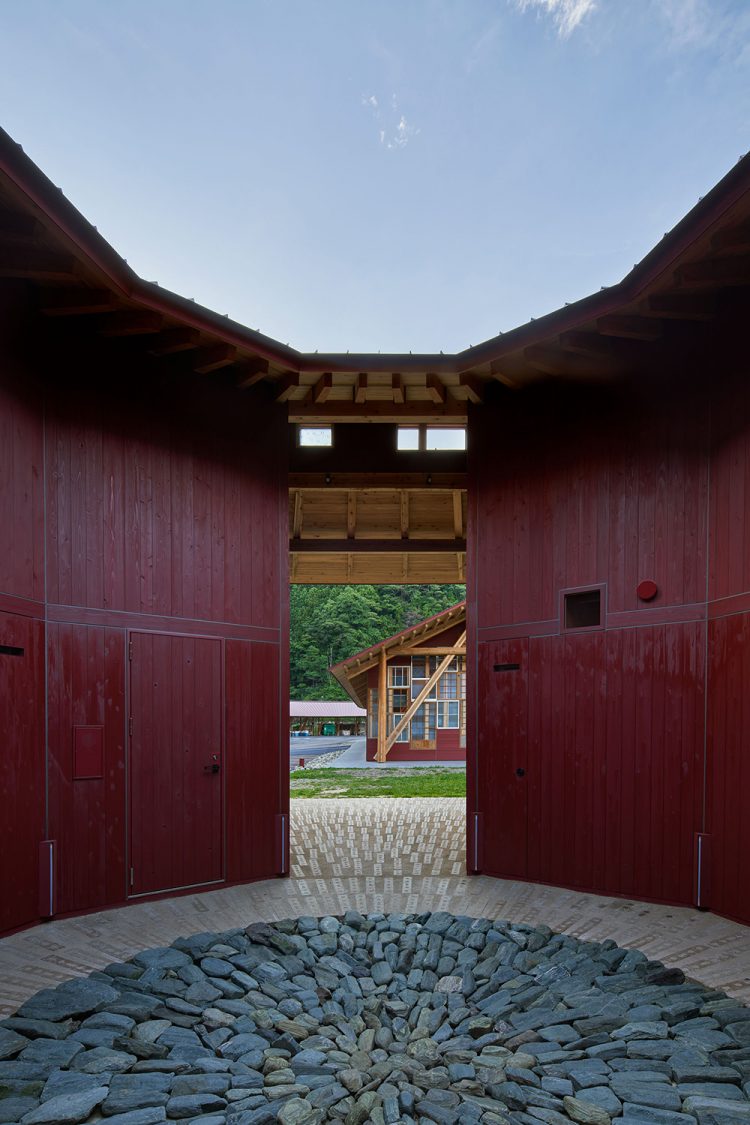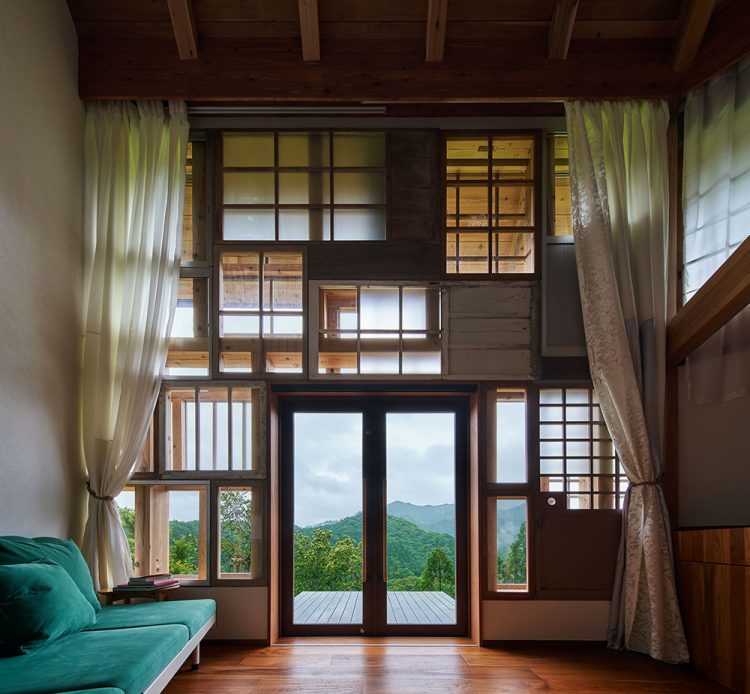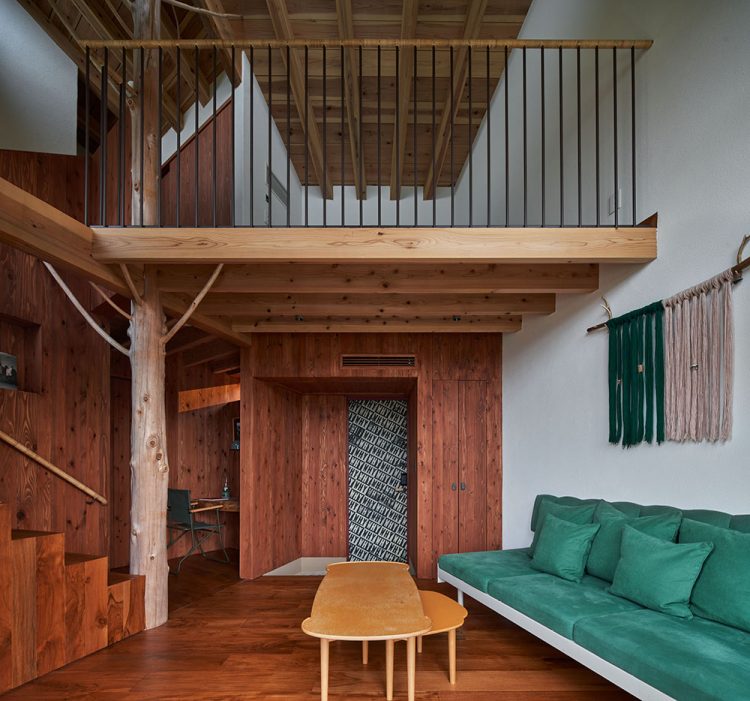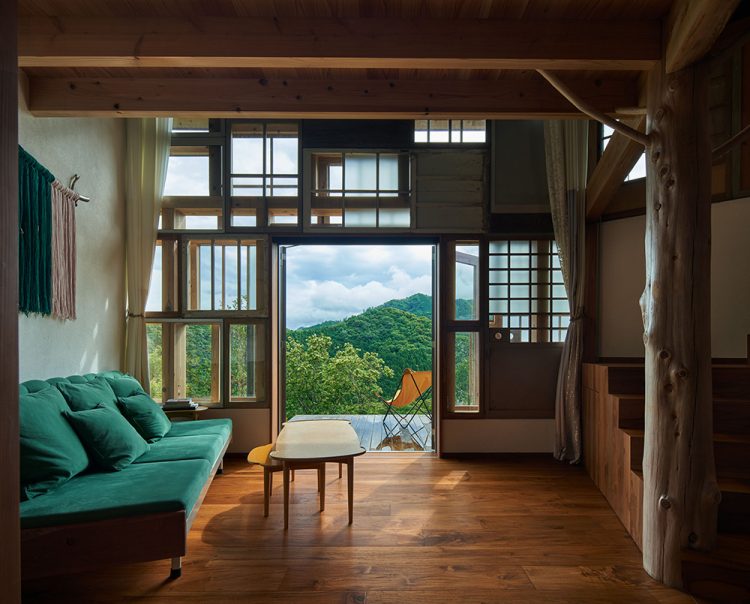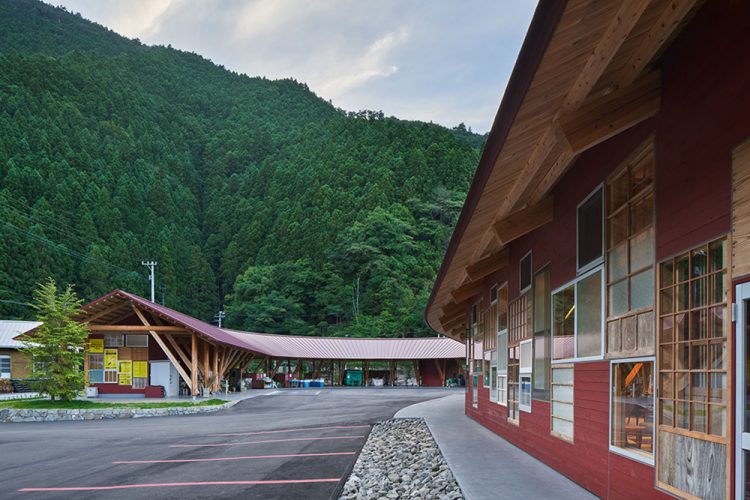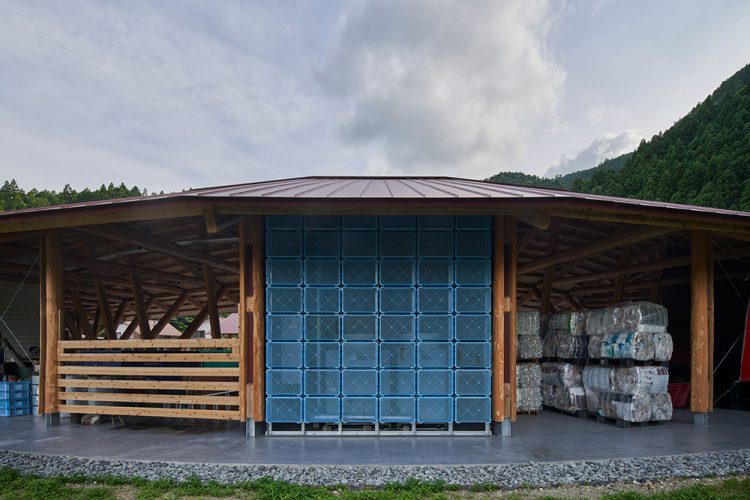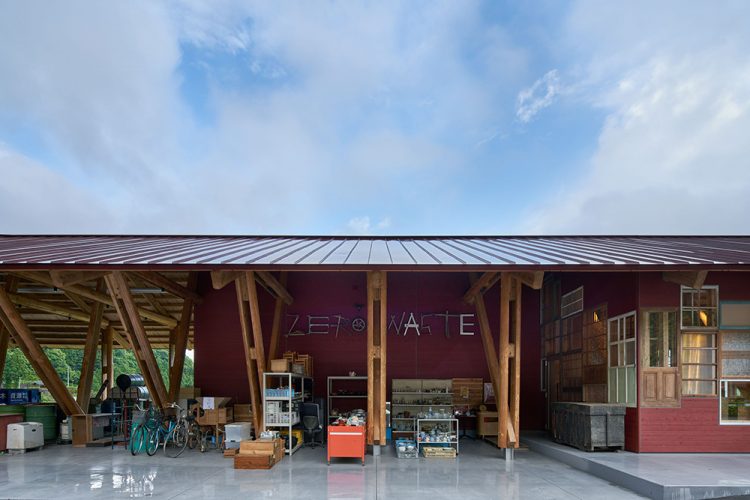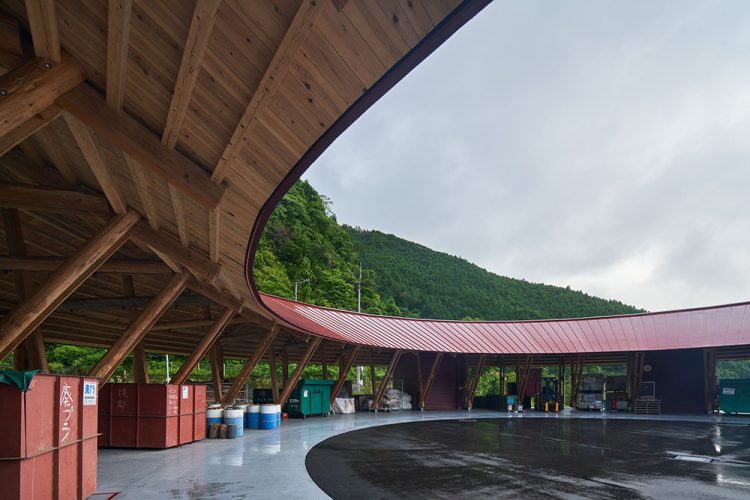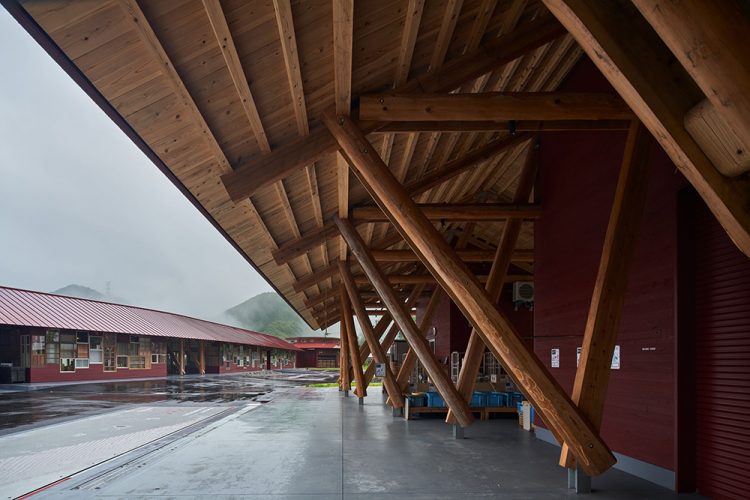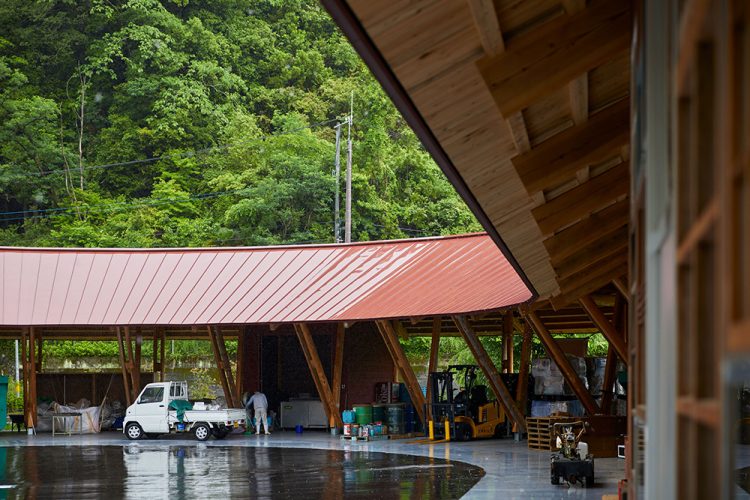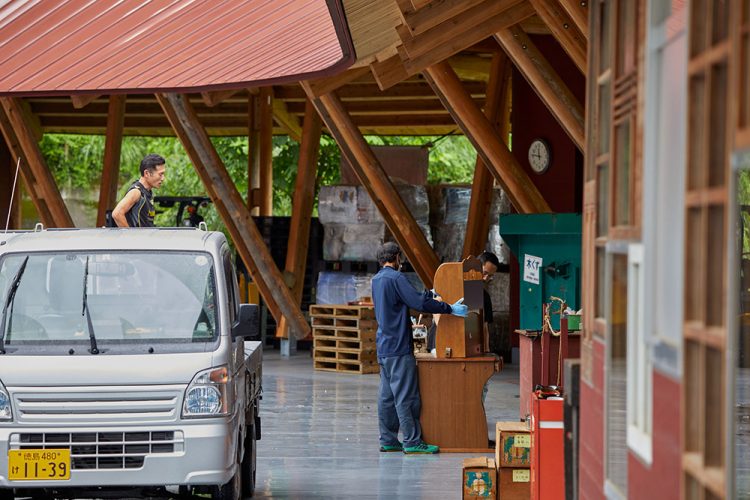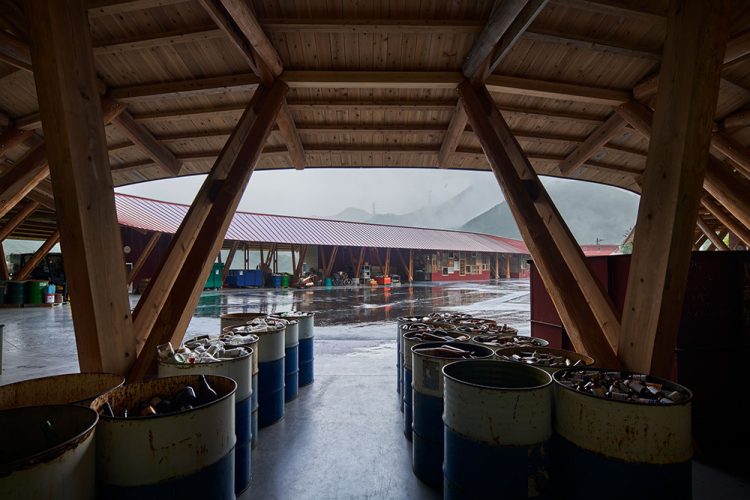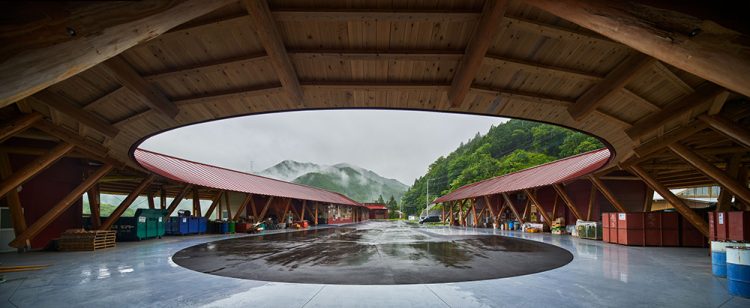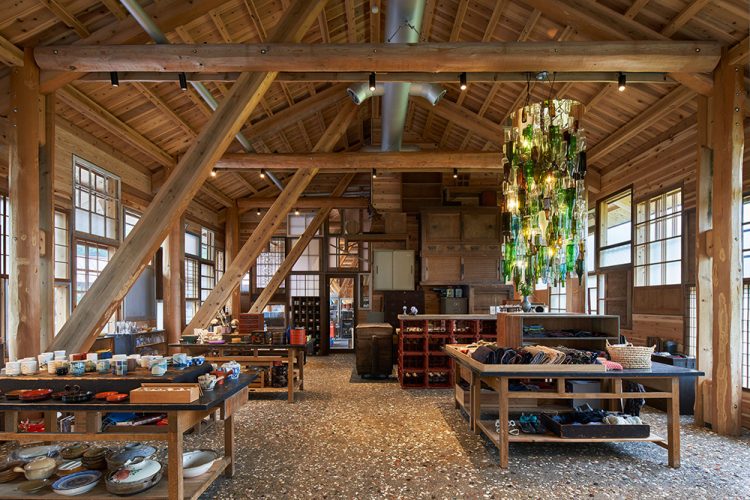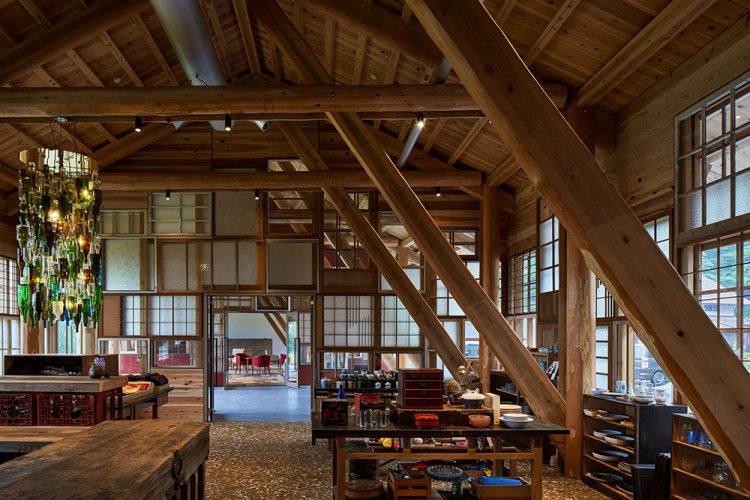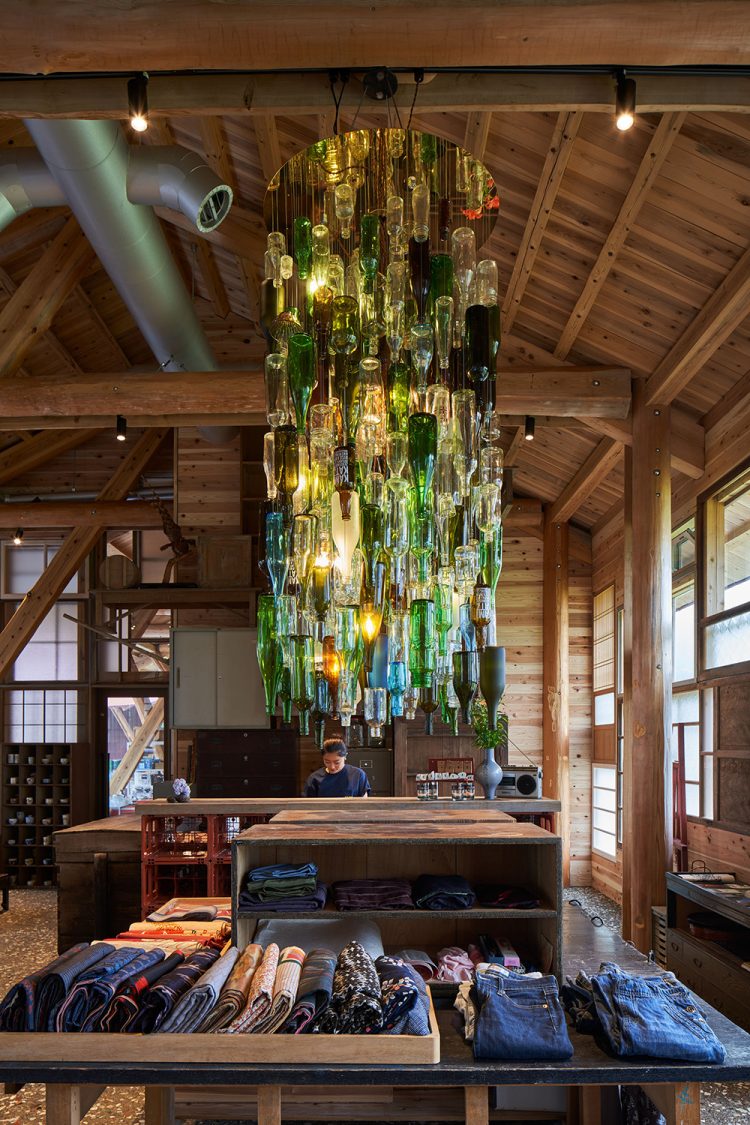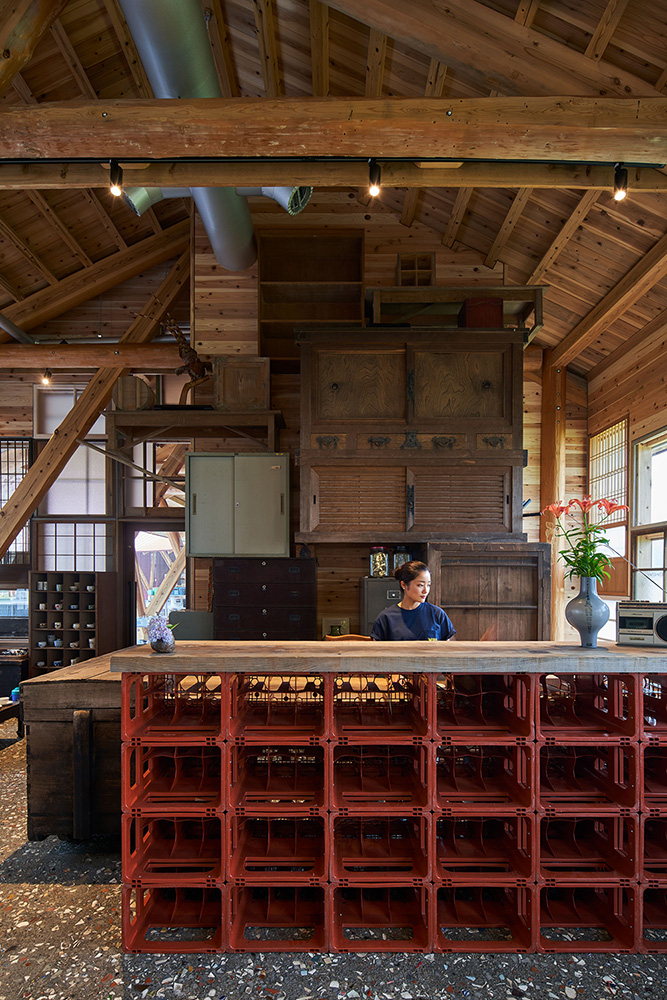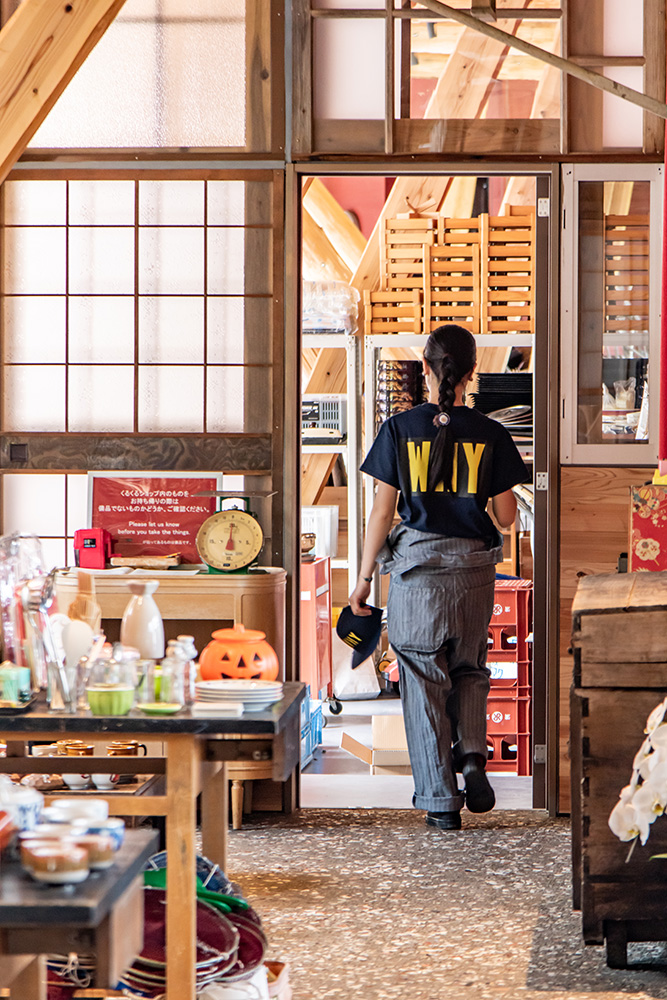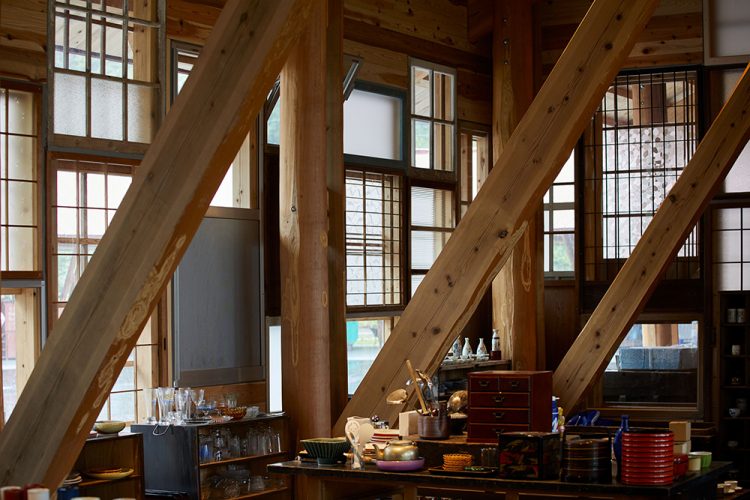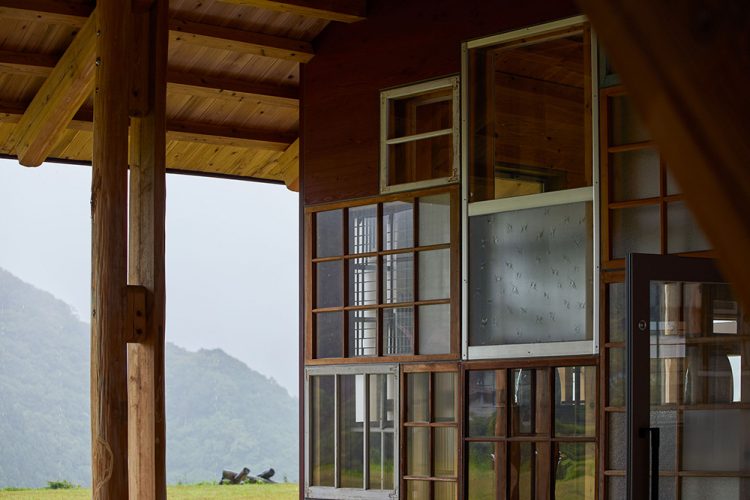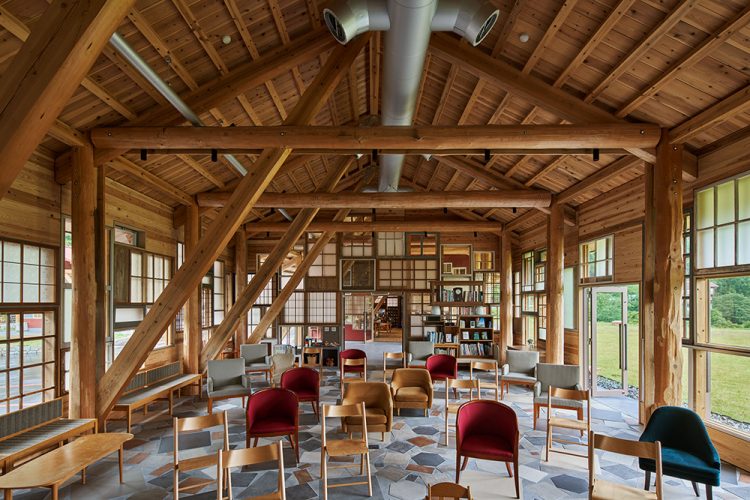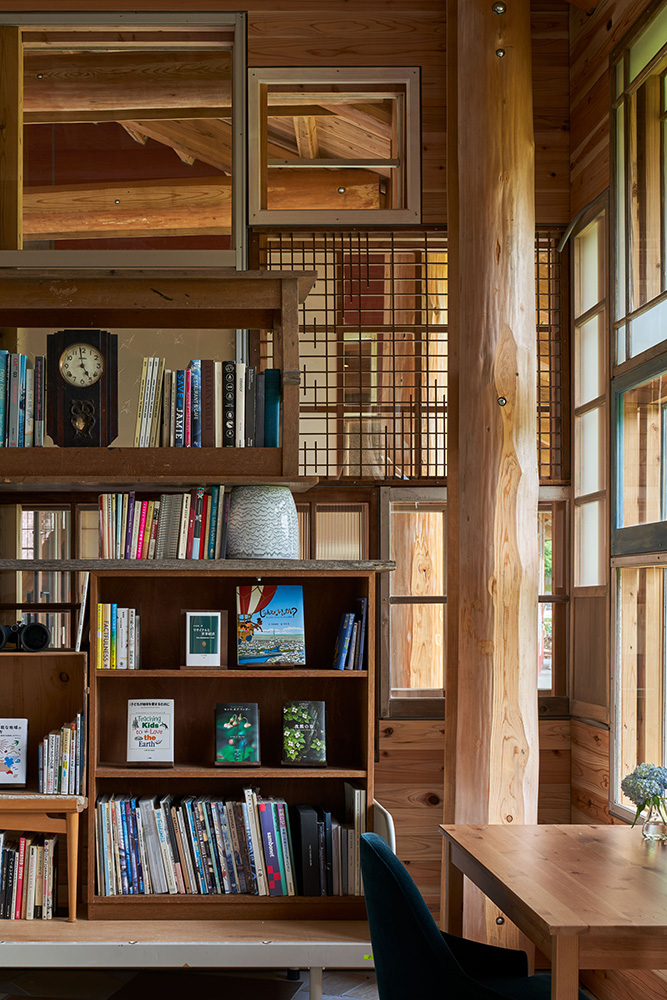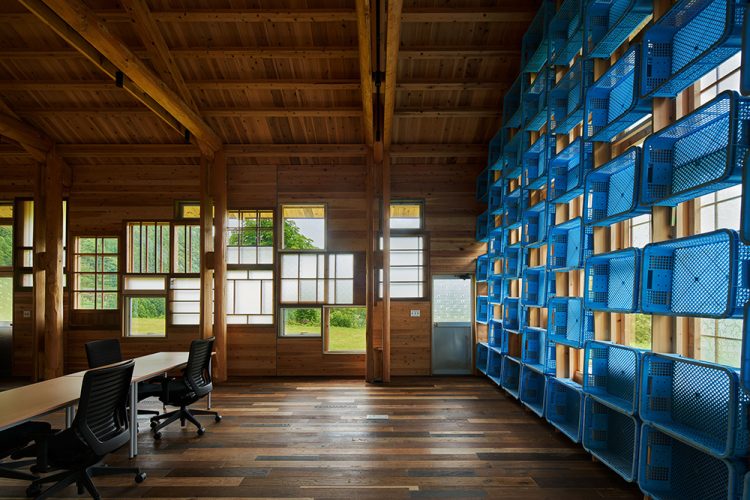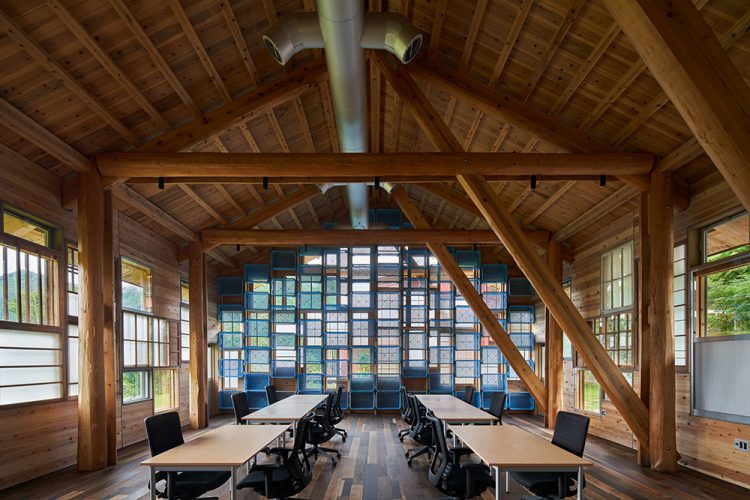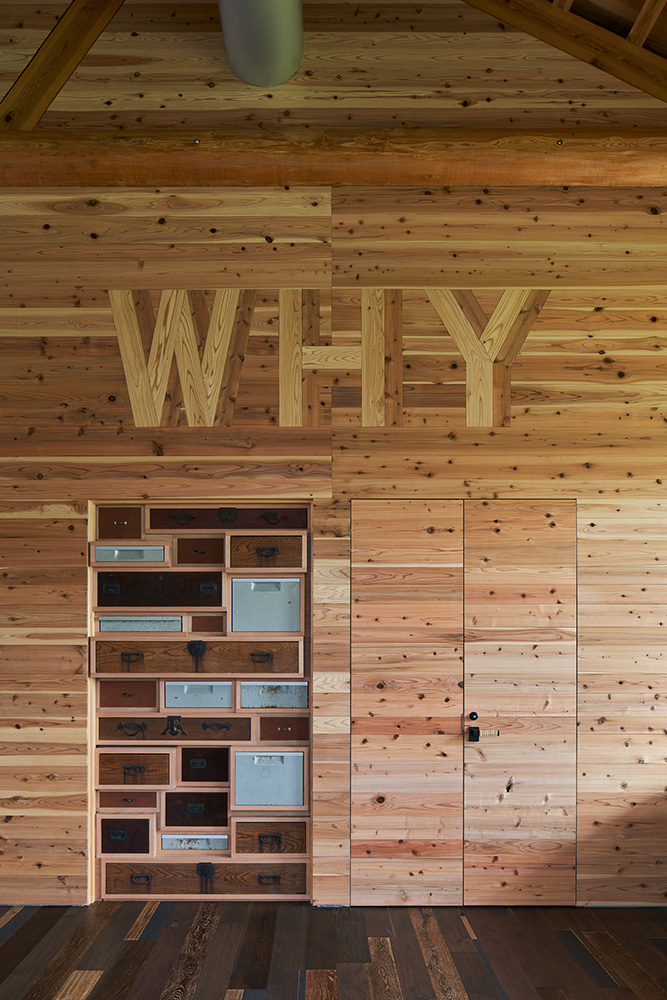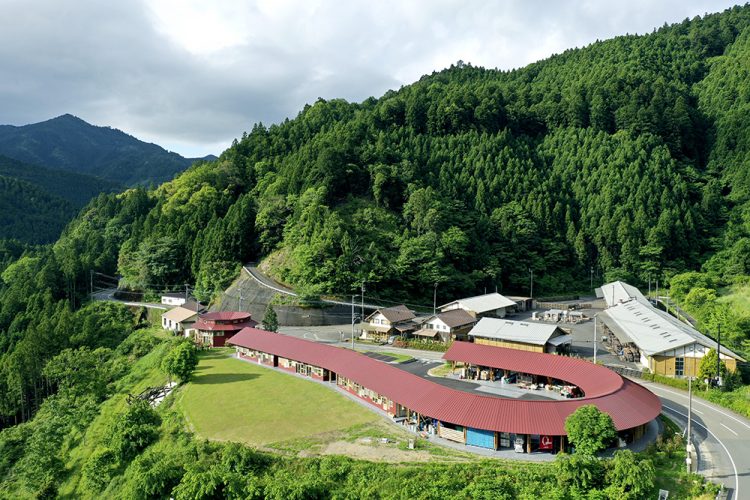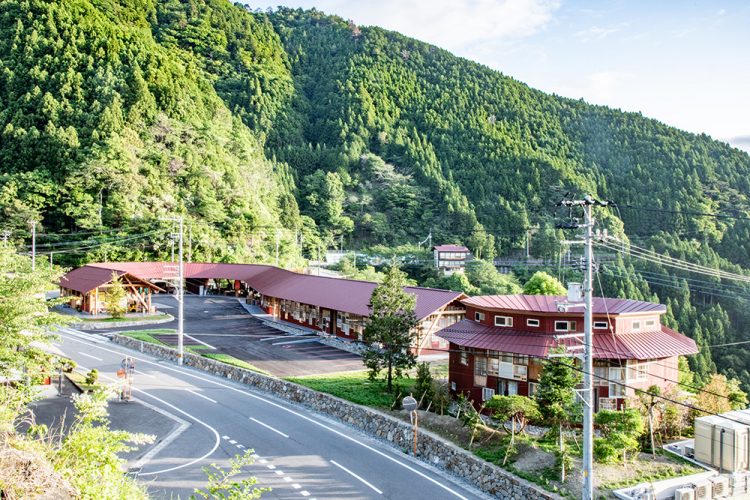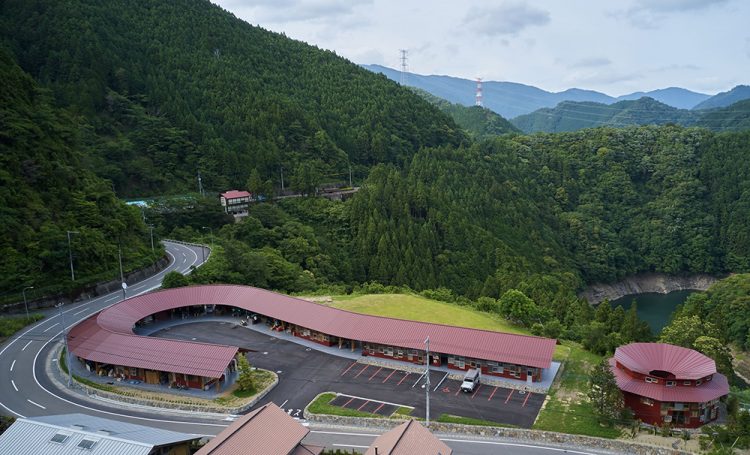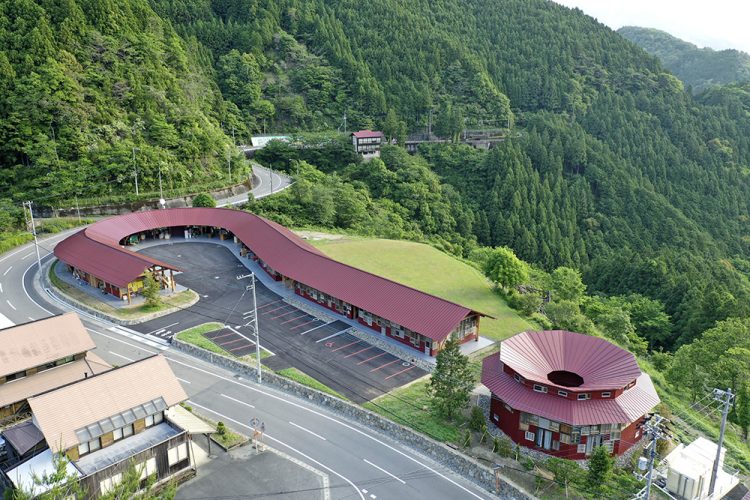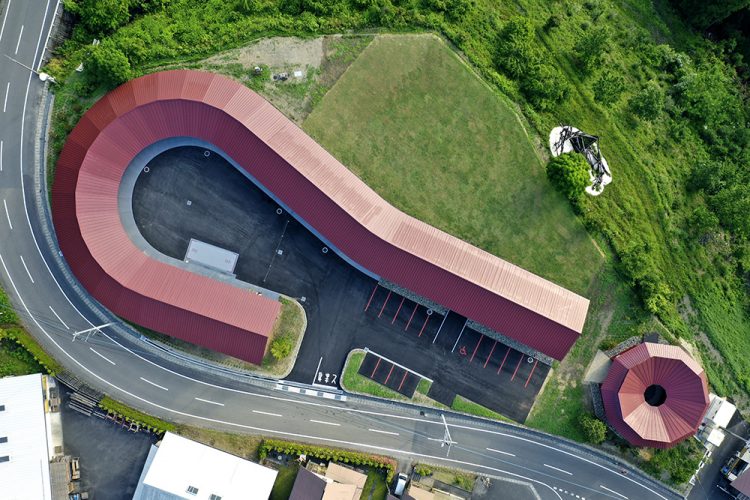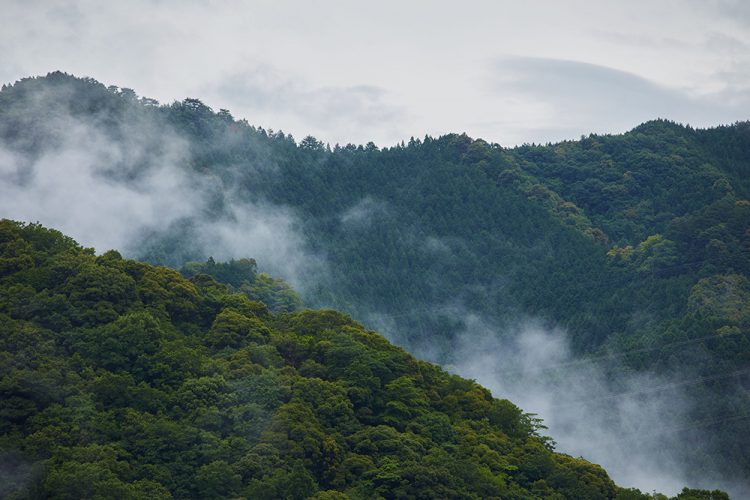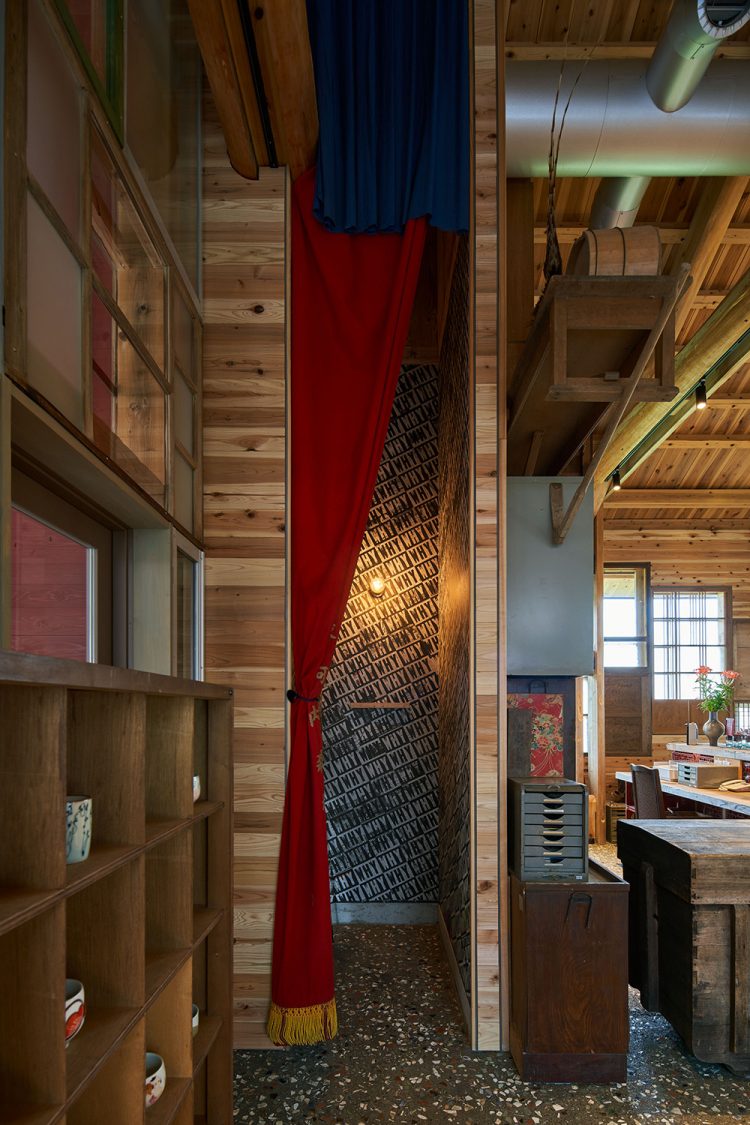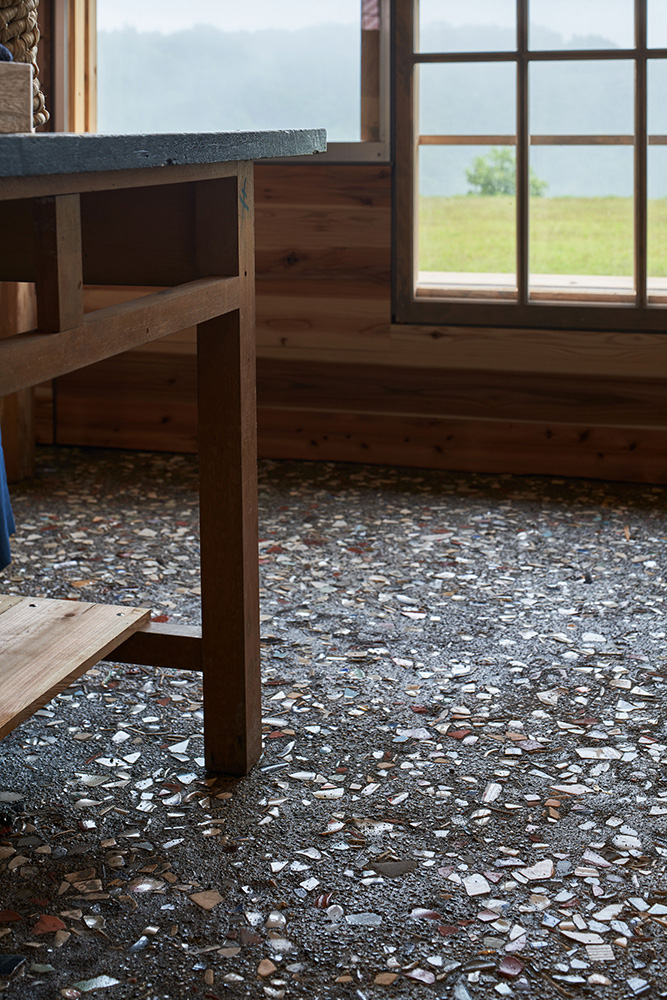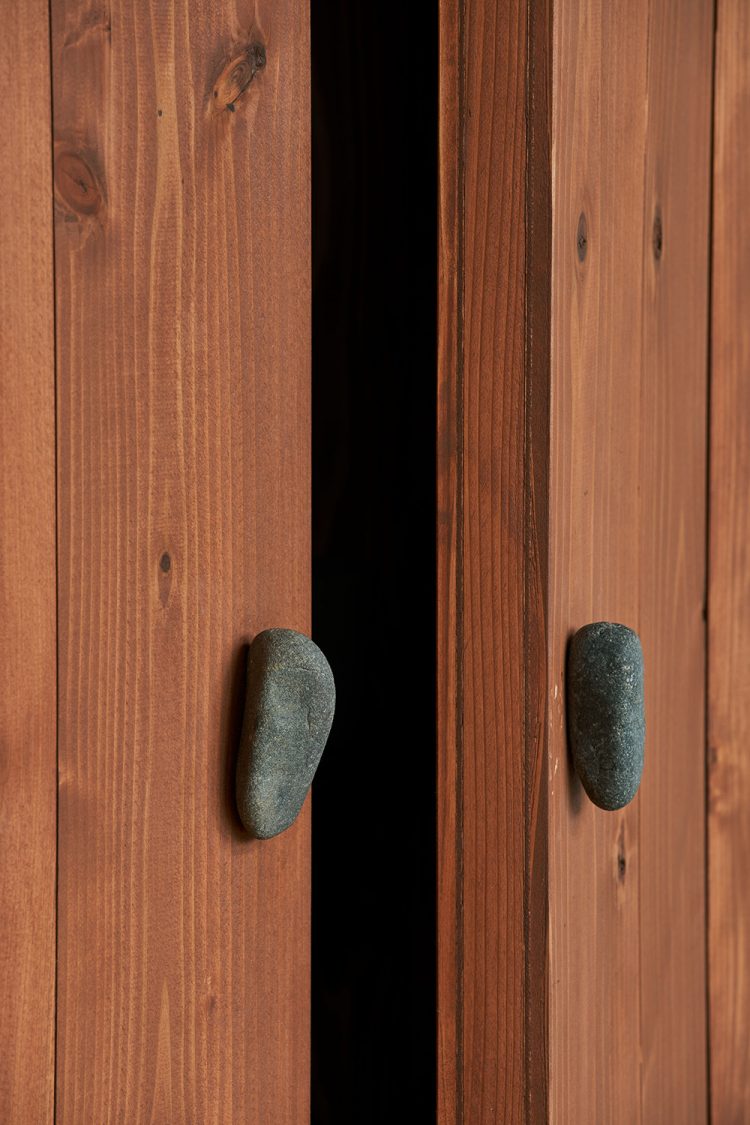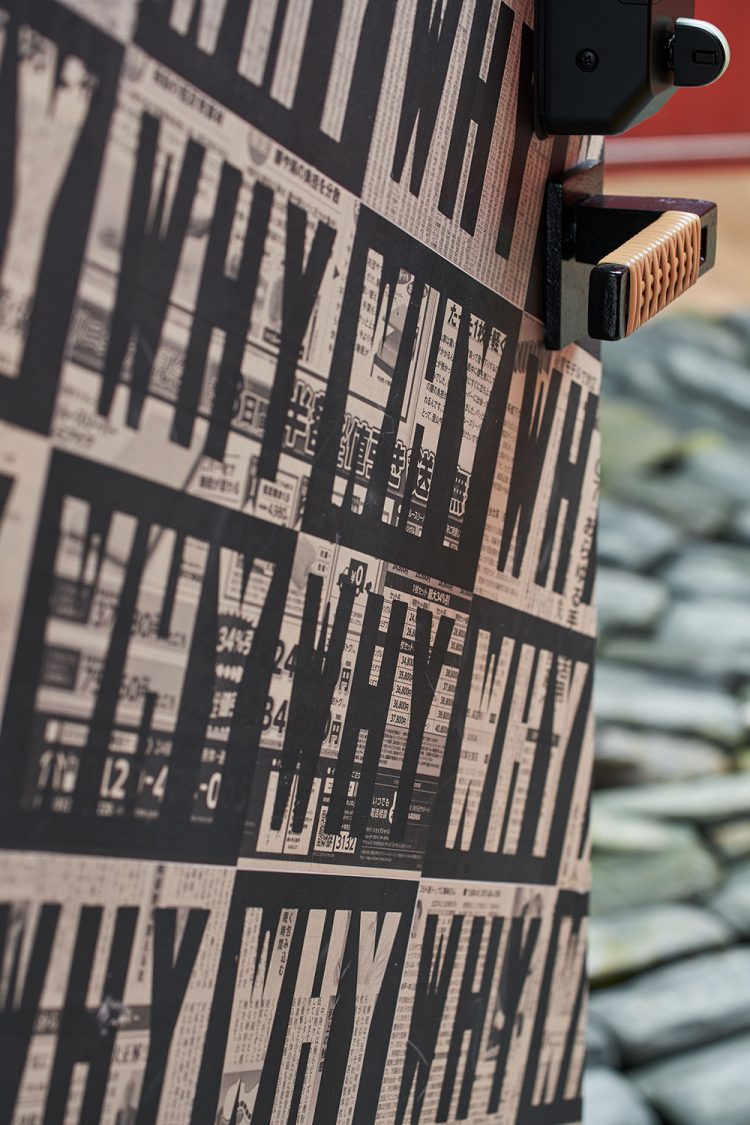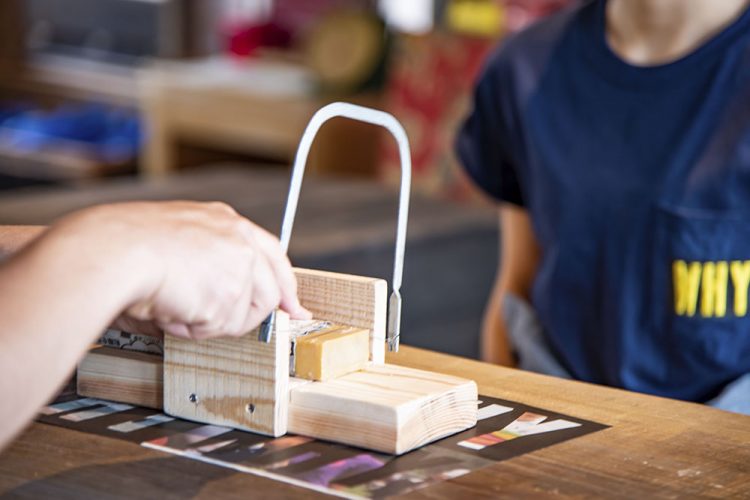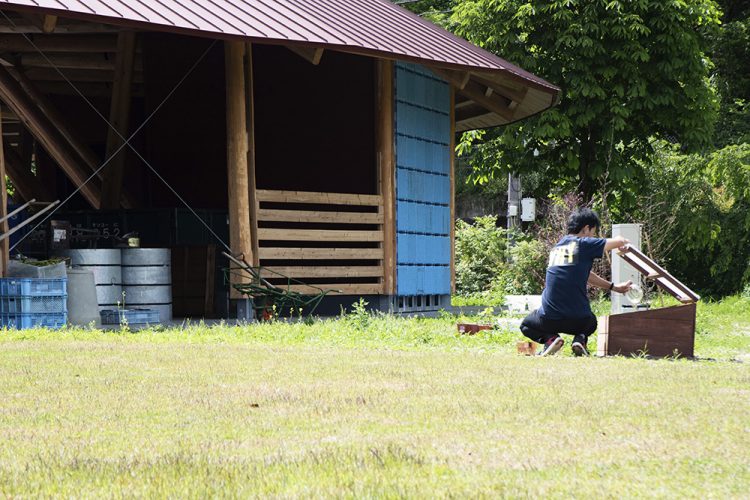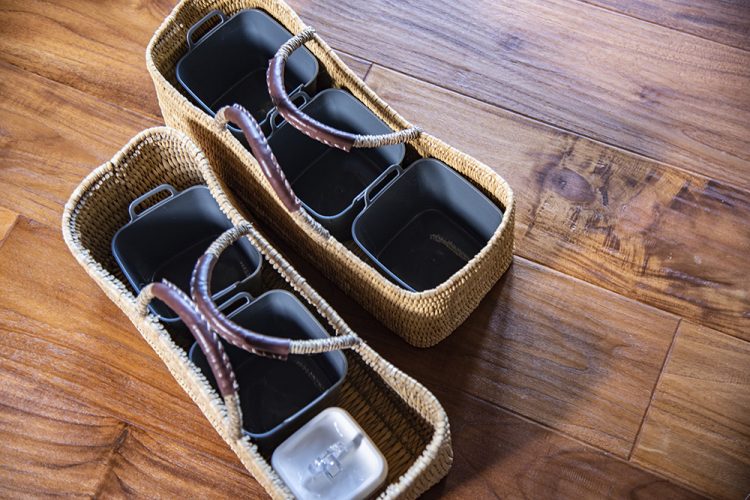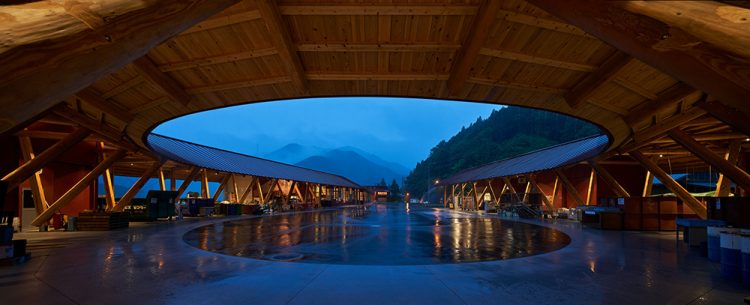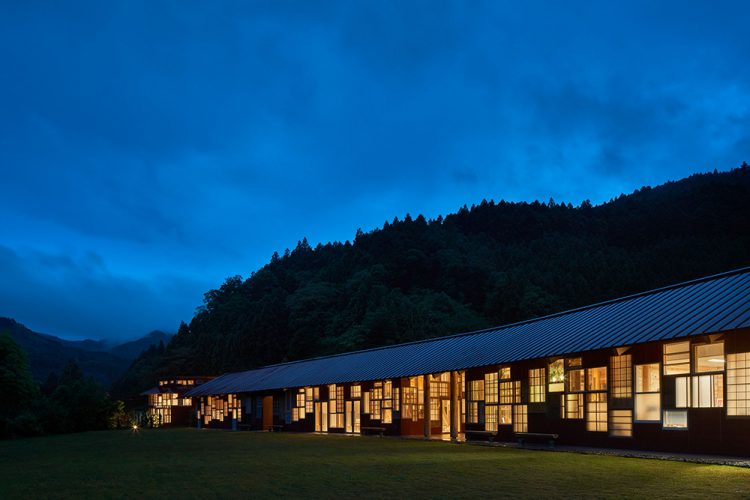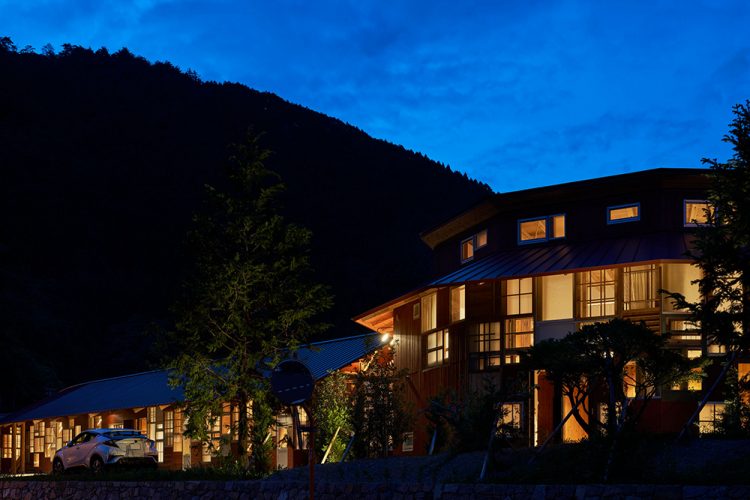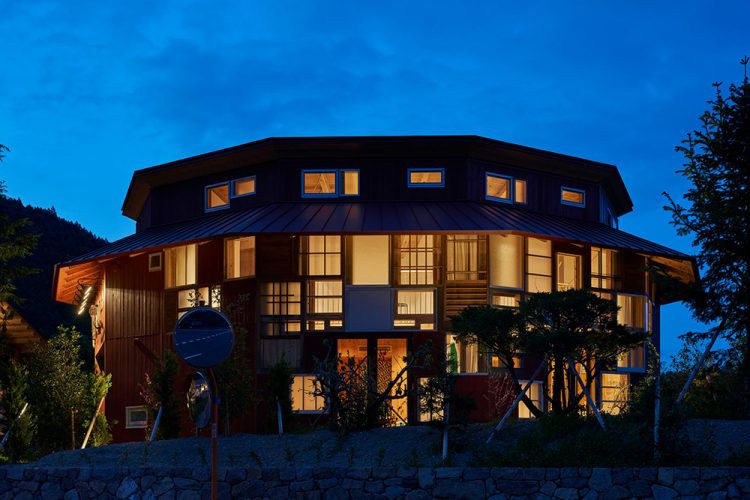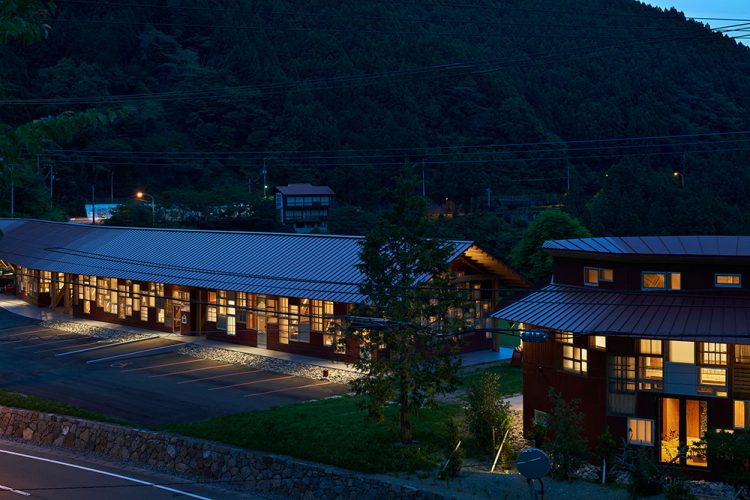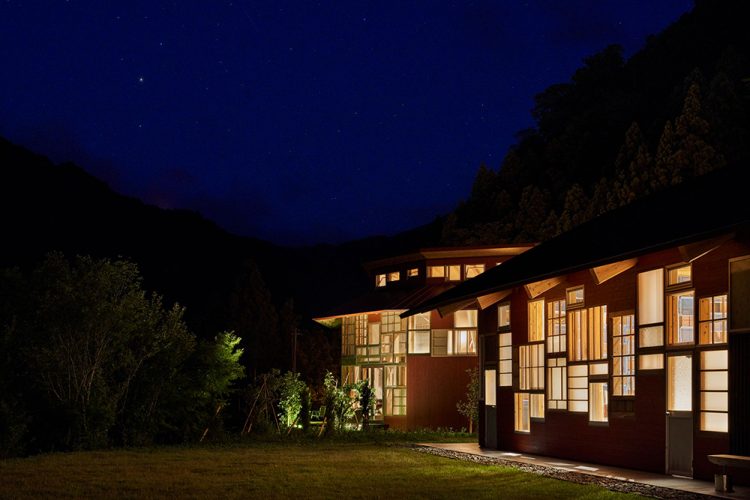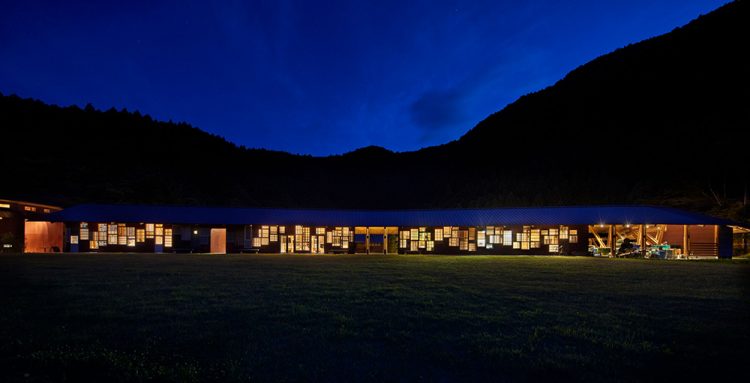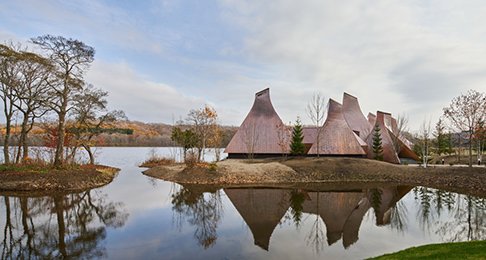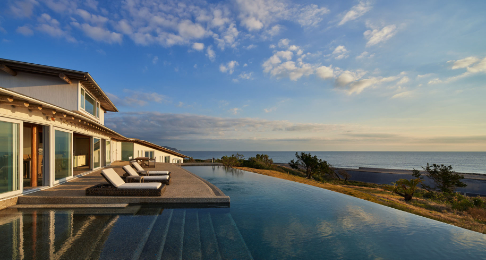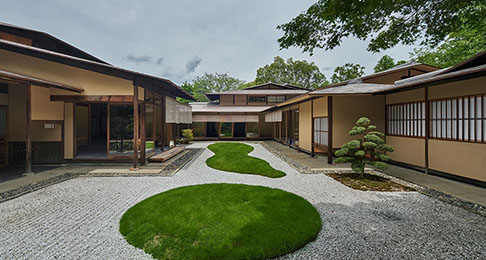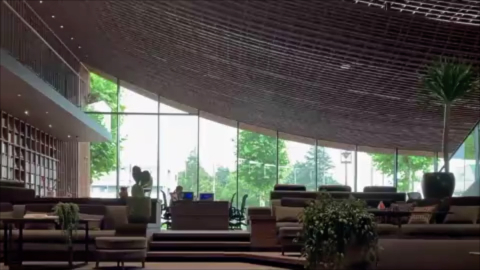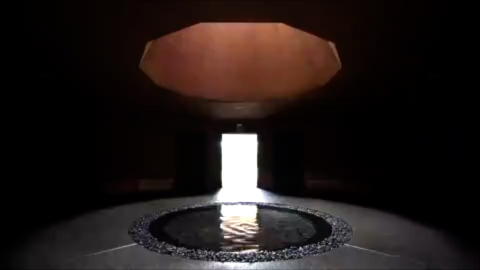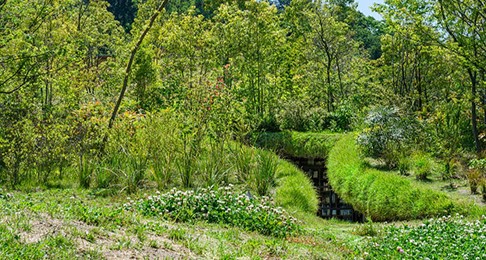KAMIKATSU ZERO WASTE CENTER
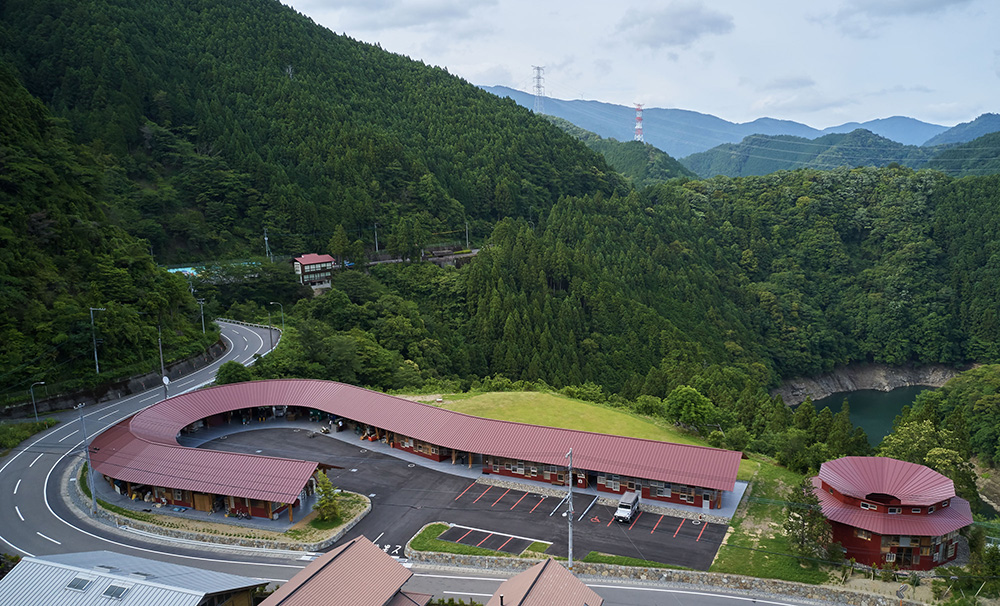
Kamikatsu is about an hour’s drive from Tokushima City, nestled in a mountainous region upstream of Katsuura River. Stunning views and rich nature are preserved, such as the Kashihara Rice Terraces (designated as an Important Cultural Landscape and as One of the Top 100 Terraced Paddy Fields in Japan) and Mount Yamainudake with its divine boulders and dense moss. Fifty-five large and small settlements are scattered between altitudes of 100 to 800 meters. The total population is approximately 1,500 (800 households), the smallest on the island of Shikoku, of which over 50% are elderly as depopulation progresses. Forests account for 88% of total area of the town, of which approximately 80% is man-made with cedar and other. However, the key industry of forestry has declined with the emergence of low-cost lumber imports. On the other hand, seasonal leaves and flowers have been tapped as a new local resource to be shipped out as garnishes for cuisine, putting the town on the map for its business of selling leaves. The elderly and women could pick these with their hands, thus creating jobs. This created a virtuous circle of industry and welfare as town residents regained their vitality and medical costs for the advanced elderly fell greatly below the prefecture average. In 2003, Kamikatsu was the first in Japan to issue a “Zero Waste Declaration” and was selected in 2018 as one of the “SDGs Future Cities.”
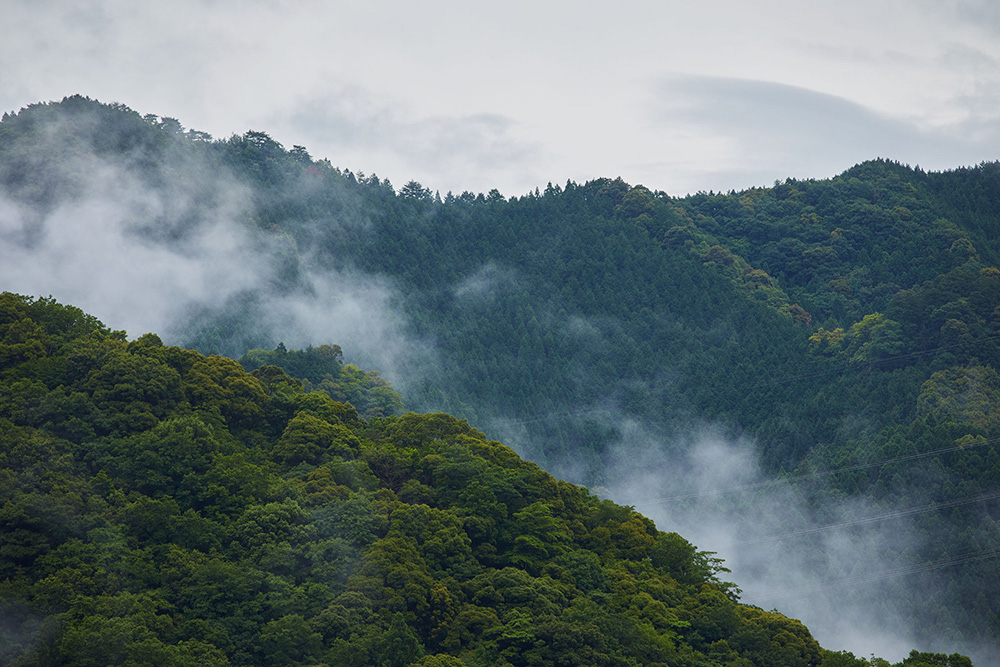
“Zero Waste ” comprises activities to reduce wastefulness, extravagance, and trash as much as possible, with the target of generating zero waste. While most conventional waste-related policies address the handling of waste, Zero Waste starts at the source. There is need for change in manufacturing, logistics, and consumption systems, as well as in the overall public to foster a society that won’t generate wastes. We also need to spread this awareness to peers and expand that network throughout the world. In a step forward, Kamikatsu became the first municipality in Japan to issue the “Zero Waste Declaration” in 2003, aiming to become a society that creates zero waste to protect its abundant nature and lifestyle. Dire circumstances were a background factor. The town needed to dispose a recently-purchased small incinerator because of dioxin issues, but didn’t have the financial resources to buy a new one. Town residents held many discussions and decided to have each household compost kitchen scraps and bring other wastes to the town’s waste station. Waste was initially separated into nine different categories, eventually increasing to 34 categories with the start of the Zero Waste Declaration and then 45 categories today. The recycling rate surpasses 80%. Amid the rich nature and beautiful scenery of Kamikatsu, the finely divided recyclable waste and neatly displayed items offered for giveaway in the reuse shop allude to a town that has new values and possibilities and has transcended the era of mass production, mass consumption, and mass disposal.
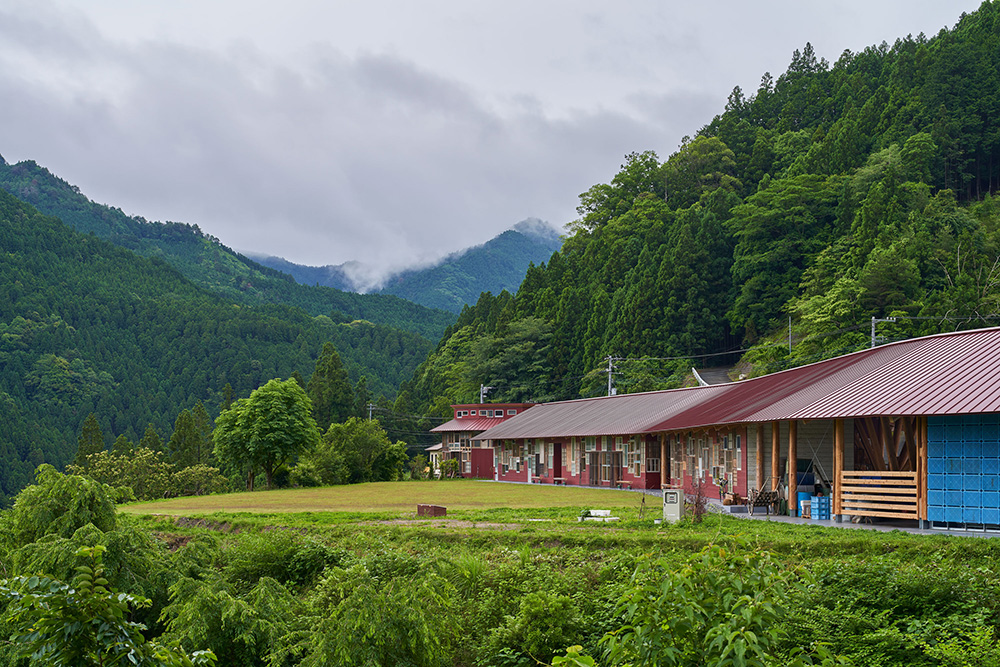
Kamikatsu Zero Waste Center embodies the principle of Zero Waste as an earth-friendly complex facility that adds the functions of education, research, and communication to a waste-sorting treatment plant, aiming to recreate community and develop the region.
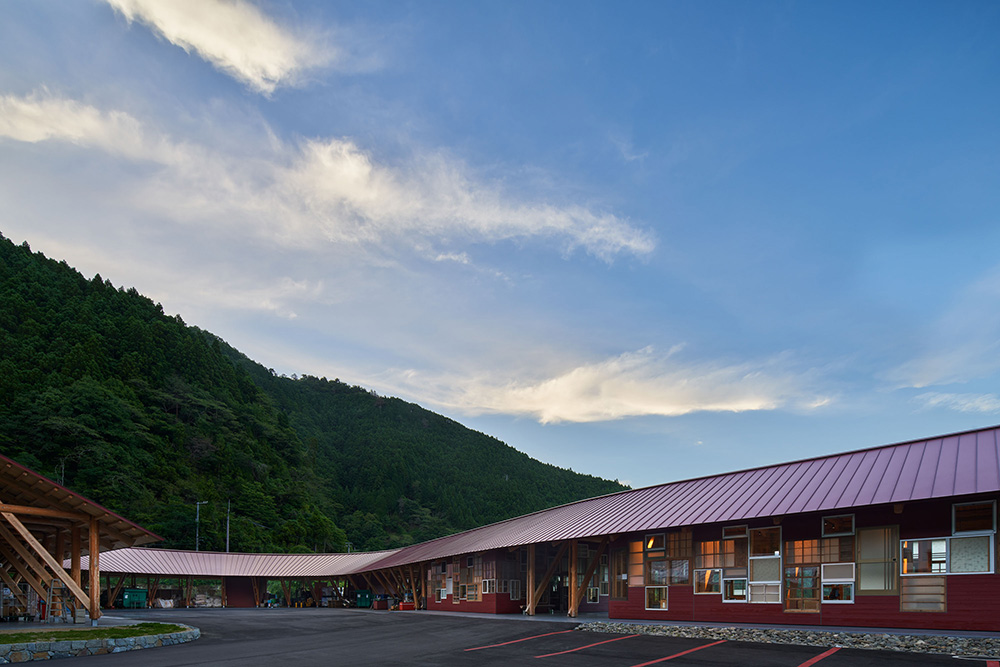
From left to right: garbage station, stockyard, repair yard, and reuse store, providing a panoramic view of the recycling process.
The site is a landfill of wastes and surplus soil from construction sites. We decided to construct the building on the mountain side where the ground is solid and place the car entrance/exit away from the winding roadway that had poor visibility. The reuse shop with a concierge function and office were placed in the center of the site with a view of the entrance/exit, flanked by the separation area mainly used by town residents and waste workers, and a community facility and parking space area that out-of-town visitors would also use. An experience-style hotel was placed as a separate building where the ground is most stable. The horseshoe-shaped plan seamlessly linked the recycle and reuse process of separate → store → recycle / sell, while the round Townspeople Sorting Plaza surrounded by large eaves is a drive-through space with full view of the stockyard, improving searchability for the 45 categories and minimizing movement distance. Forklifts and trucks would come and go in the afternoon to collect recyclables, so the tourist and observing visitor traffic area was placed in the periphery of the building. This also served to separate pedestrians from cars and protect the privacy of town residents who came to dispose of wastes. Beyond the waste disposal path lies the reuse shop, community hall, and encounter hall that leads to the grass field with stunning views, with the intention of encouraging interaction between townspeople as well as with town visitors.
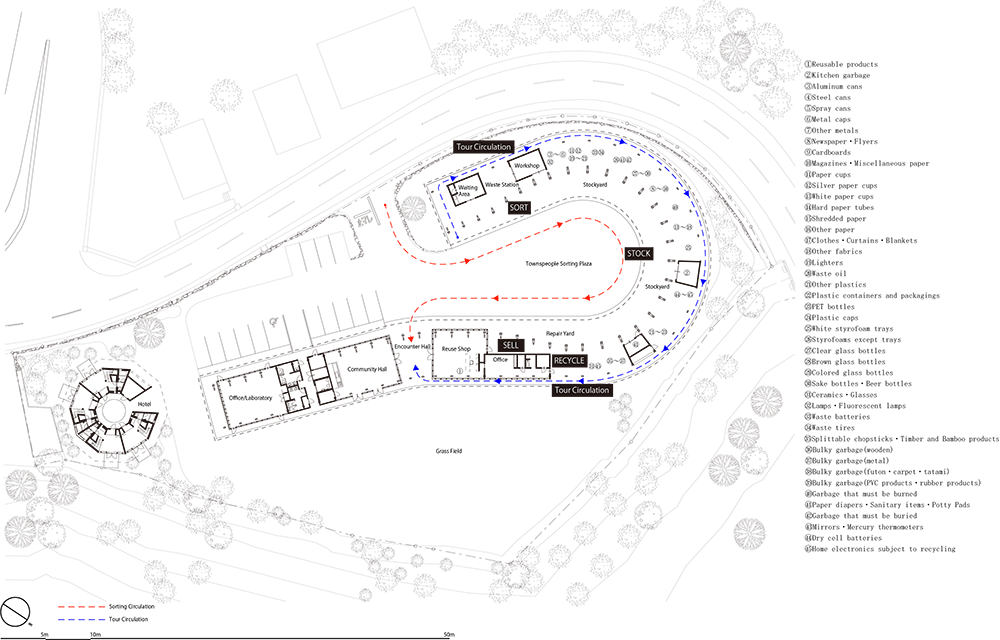
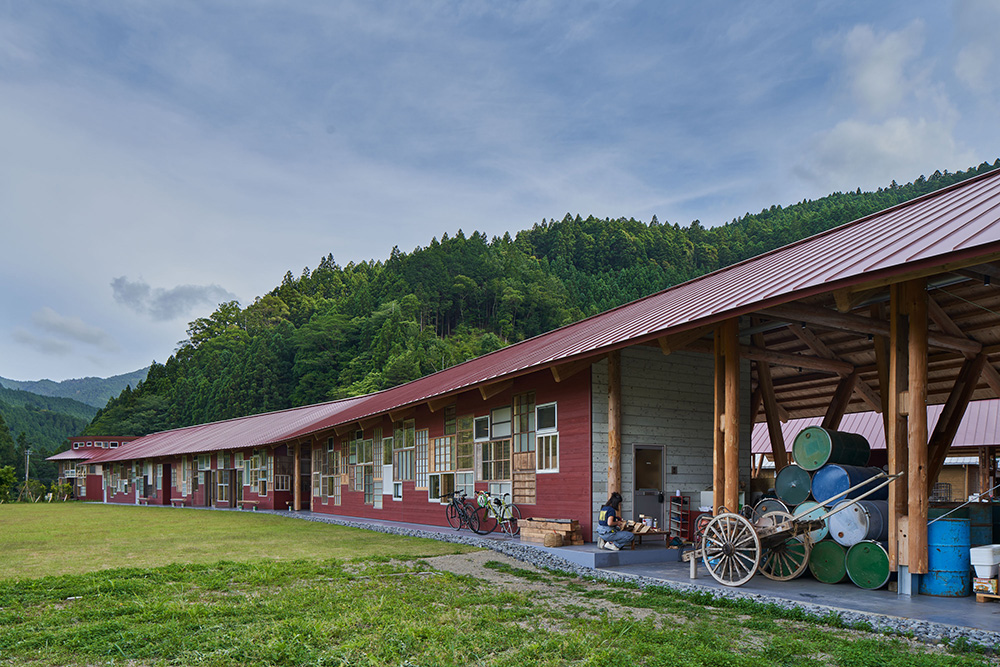
The goal was to create a seamless architecture that would not look out of place even if the garbage were lined up next to each other.
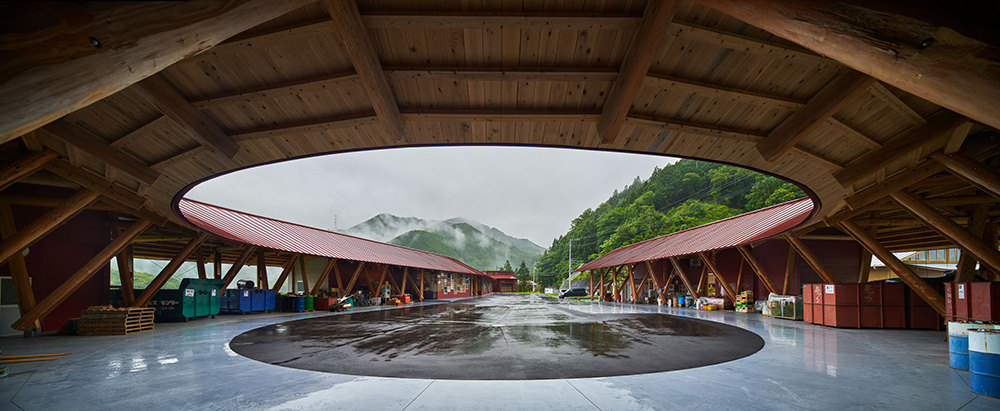
The drive-through sorting square provides a highly searchable space with a panoramic view of the 45-sort container yard.
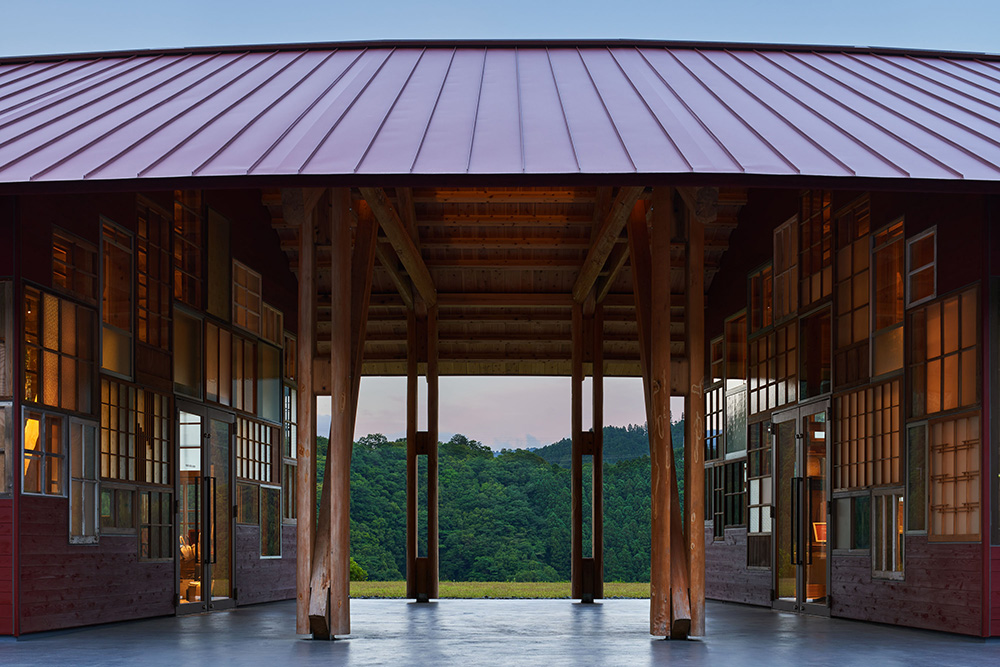
On a site that was once a waste field and landfill site, a facility has been created to protect the rich natural environment of Kamikatsu and to pursue a sustainable future.
Making use of local resources; ensuring resources aren’t wasted and planning construction so waste materials are minimal. Forgoing materials from outside the area served as the first step to reducing wasteful packing and transport costs, as well as fuel. We also repeatedly visited not only the former waste station, but also deserted houses in the town, the former government building before being demolished, a junior high school that had been closed, etc., and were dumbfounded by the truths of adversity and depopulation. We thought hard about the design with the aim of bringing value to what was no longer being used. The buildings employed materials that we considered to be resources rather than wastes.
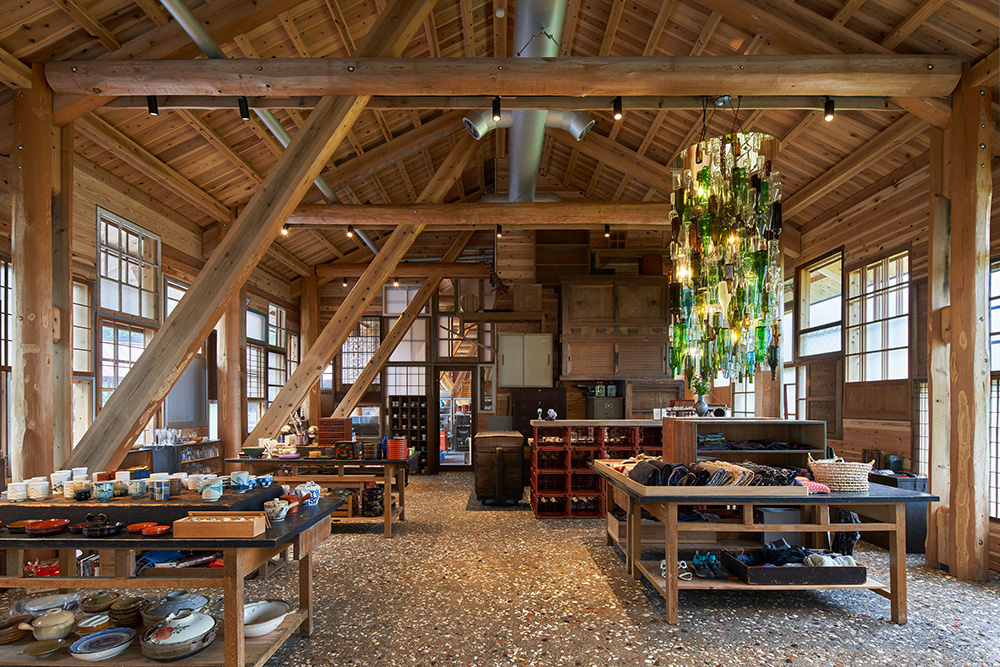
The Reuse Shop is a place where townspeople can bring in items they no longer need, which anyone can take for free. A variety of waste materials were creatively reused as an interior finish.
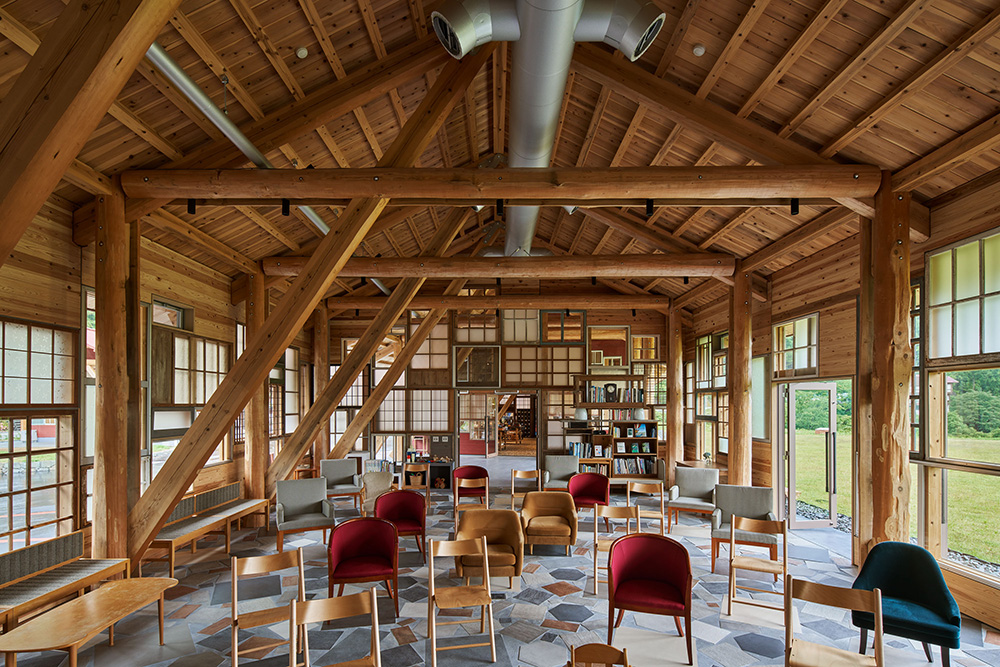
The community hall is used as a lounge for town residents and a hall for corporate training. The tiles of different colors and shapes are arranged in a radial pattern so that various chairs can be placed stably.
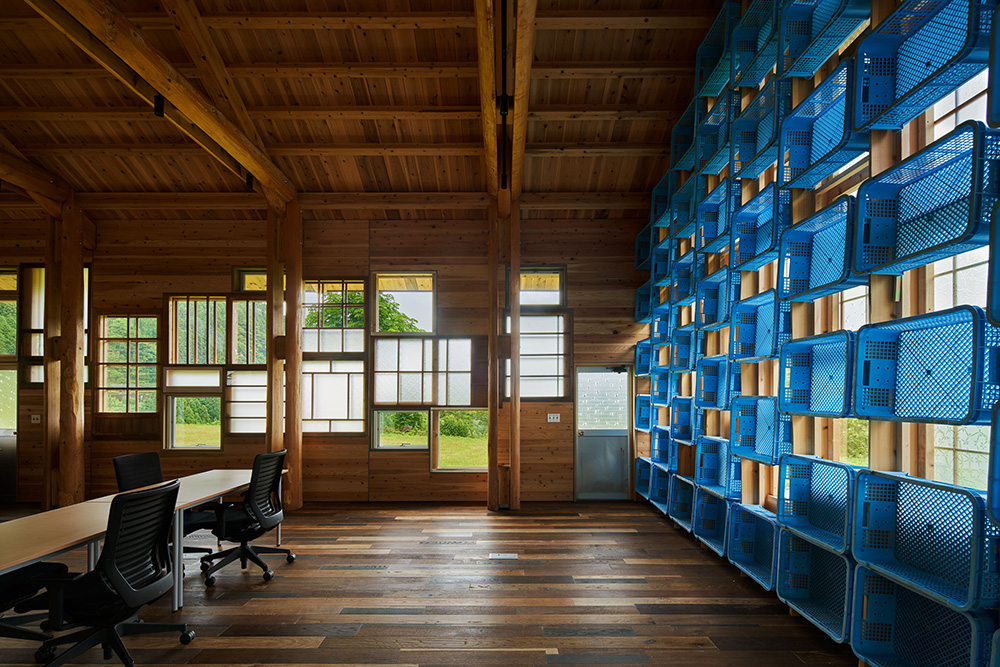
Harvest containers from a shiitake factory were reused as a blindfold for mechanical space and bookshelves that also prevent buckling of mullions.
Based on the Zero Waste principle, we made it a rule to use locally-grown cedar wood for the structure and interior, holding many meetings with the Kamikatsu municipality, forestry cooperative, lumber producers, and wood-processing vendors from the initial stages of preliminary design. The municipality asked for a space where wind and light pass through and the smell of waste is not stagnant. It also requested that the eaves be high enough for large trucks to pull up. As architects, we also set the design condition that the structured system be flexible and sustainable so it can continue to be used with renovations if the facility purpose should change in the future. We decided to use 70- to 80-year cedars with diameter from standing timber to tip of 250 millimeters, which was the most common slumbering timber in the town’s forests, for the building structure. We planned for maximum length to be 8 meters, which could be dried using equipment in the town. However, if we started cutting wood in the mountain and drying it after choosing the contractor, we wouldn’t be able to keep the construction schedule. We thus negotiated with Kamikatsu and separately ordered a total of 350 cedar logs over one year in advance of construction start, in the form of having the town provide the materials. By having local vendors handle logging in the mountain, lumber manufacturing, drying, and processing, we contributed to the local economy and revitalized woodland resources. Sourcing square timber from raw wood creates a great amount of loss by creating waste, reducing structural resistance, and making material length shorter. On the other hand, logs can be used almost in their unprocessed form, making it easy to acquire long material and offering the dynamic benefit of maximum cross-sectional performance. However, diameters and shapes vary and there is bending, which requires sophisticated carpentry skill for processing and assembling. We decided on architecture that took advantage of the logs, employing a simple jointing method with diagonal pillars and climbing beams of roughly sawed boxed timber being inserted to pillars and flat beams of half-split timber, and fastening the cut side of materials with bolts. Also, employing an open structure facilitates maintenance such as replacing corroded materials and reuse after dismantling. This was our own answer to compound waste that is difficult to separate and dismantle—a major issue of towns looking to recover resources. Further, when reusing roughly-sawed timber offcuts for outer walls and as interior materials, we accepted wooden boards of varying widths and delegated these to the walls to minimize the generation of wastes.
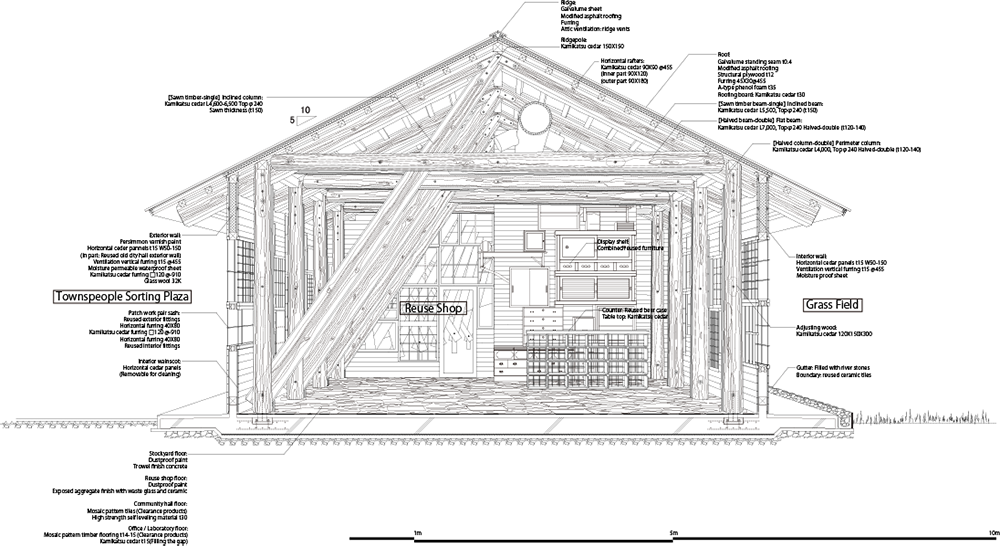
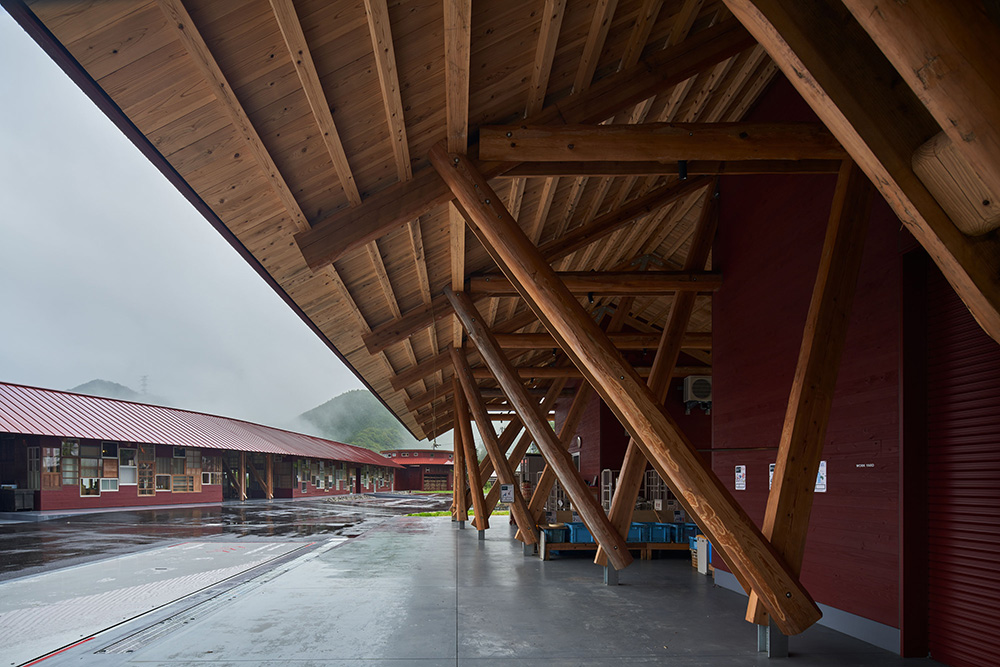
Transforming structure. A truck scale to measure the load is buried in the left road surface.
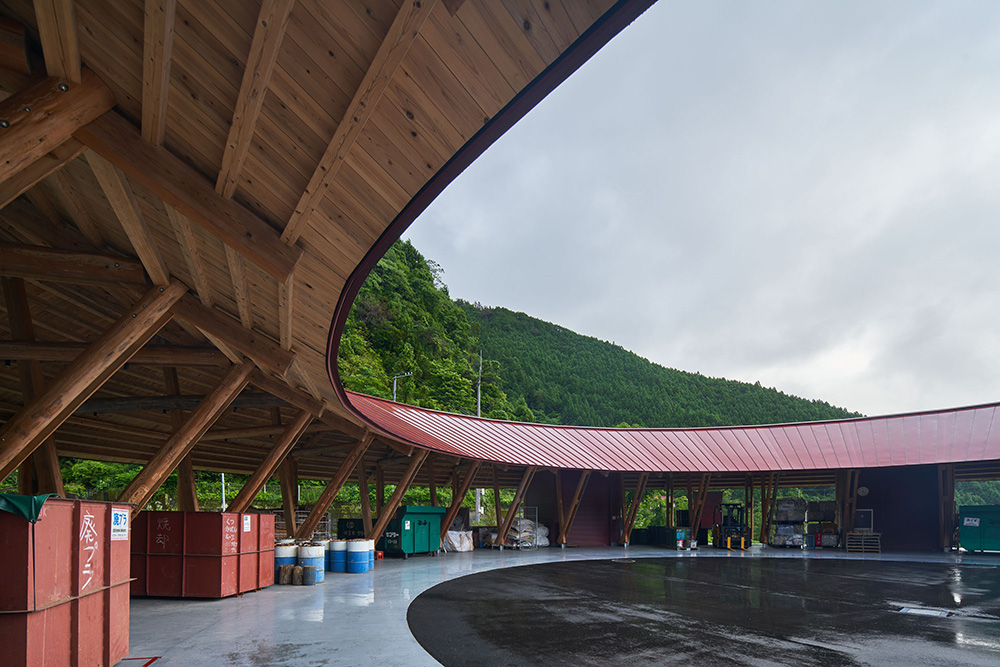
The column legs are gradually offset to allow easy access for forklifts and vehicles.
Aiming to build a beloved facility where townspeople would feel pride in the town’s initiatives, we issued a call for certain types of wastes at resident briefings and on the local public relations magazine. In result, approximately 700 fixtures were collected in a town with a population of under 1,500. The collected fixtures were used in a patchwork double-glazing facade that would serve as a signature of the building. We also used: pottery shards from broken tableware as washout-exposed aggregate floors; bureaus and farming equipment as display fixtures and signage; and farming harvest containers as book shelves, strategically placed to prevent buckling of the glaze mullions from wind pressure. We used letterpress to print “WHY?” on consumption-inciting newspapers as a message to reevaluate consumer society and diverted these as wallpaper. These examples show how we creatively combined various wastes with an awareness of upcycling. It should be noted that in using these waste materials, we arranged for the town to provide us with the materials with authorization from the local assembly and town hall to ease the performance/quality guarantees and defect liabilities that are generally required for public buildings. This architecture would have been impossible without the cooperation of the townspeople and town hall.
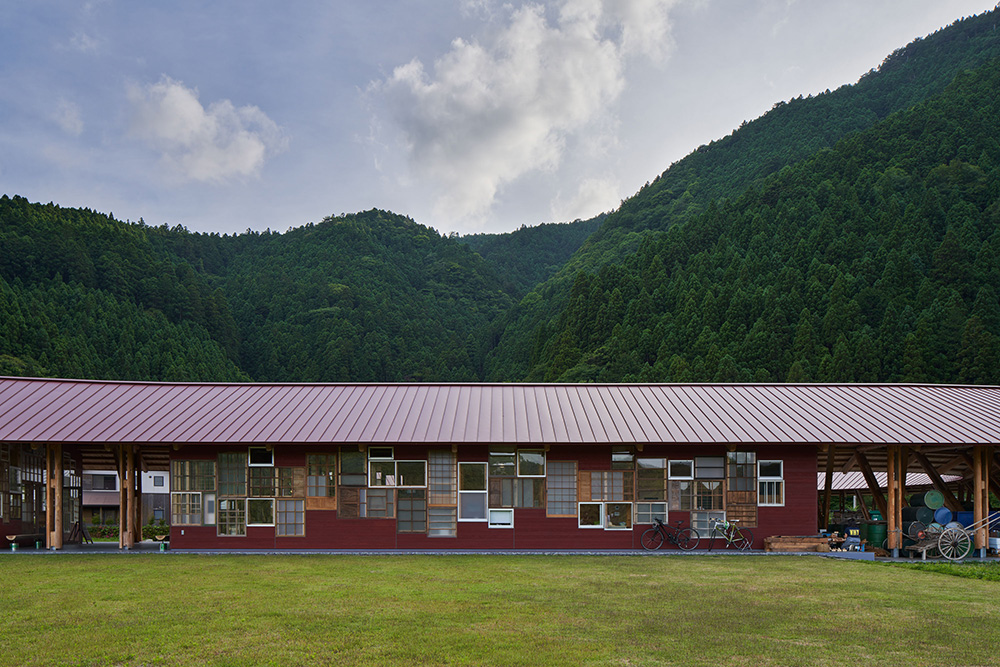
A patchwork window made up of about 700 pieces of fixtures gathered in a town with a population of less than 1,500.
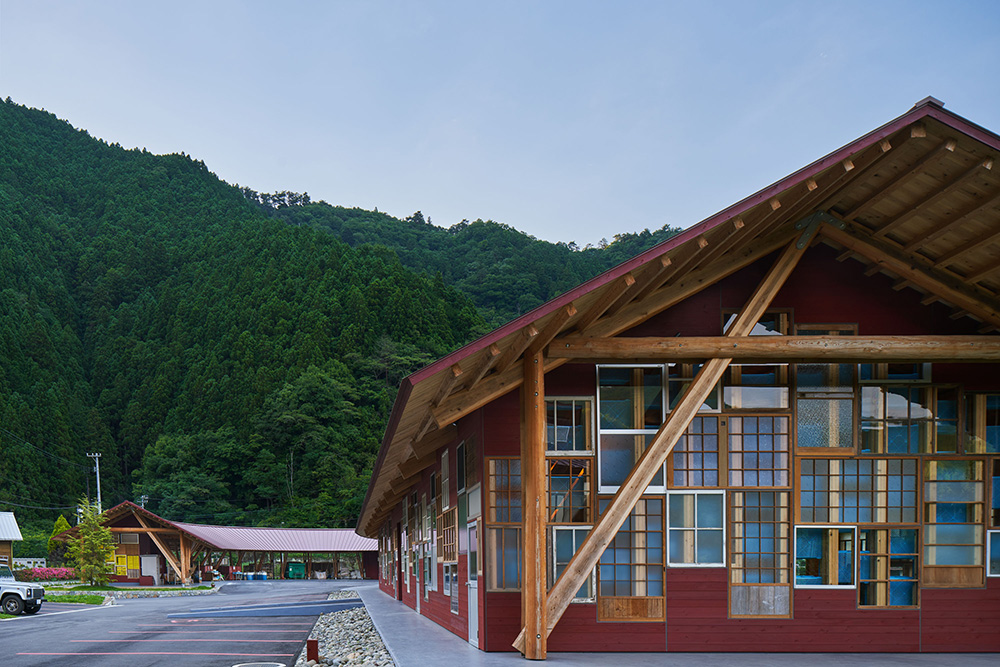
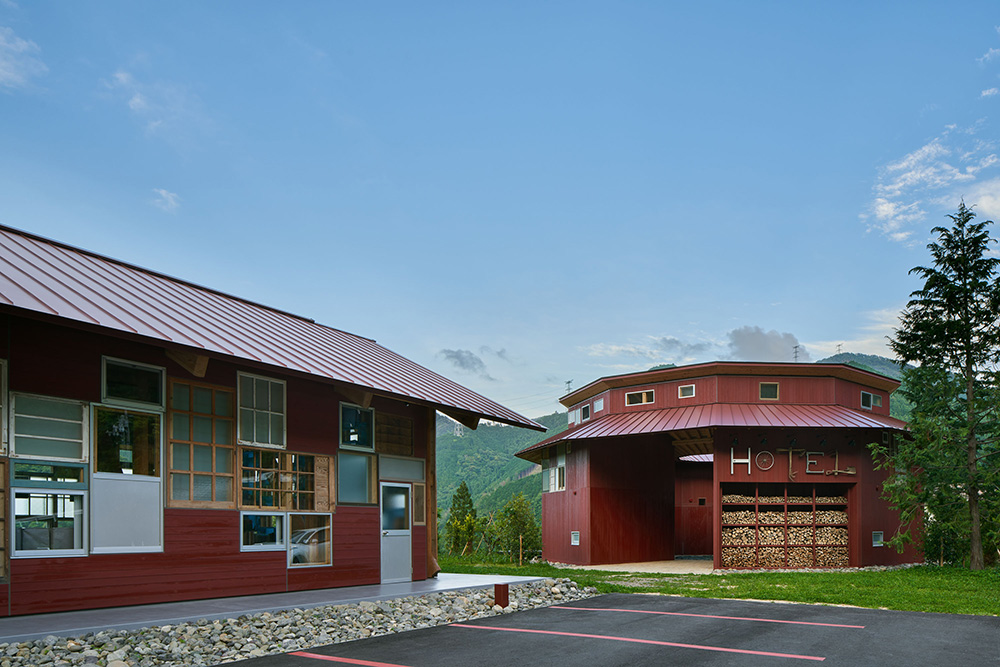
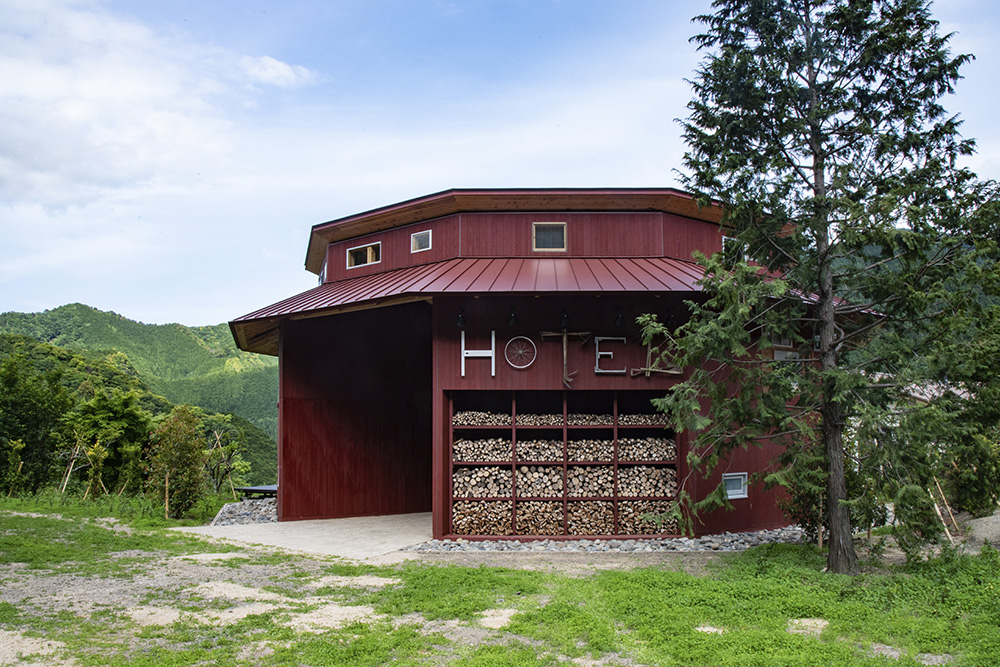
The hotel consists of four maisonette-style rooms arranged in a circle.
This hotel was planned to be round like a dot at the southern end of Zero Waste Center, which is horseshoe-shaped as a result of optimizing and streamlining waste separation, intentionally placing both buildings so they take the shape of the “?” mark. The “?” mark can be perceived only from high up in the sky, but we instill our hope that this town questions our lifestyles anew on a global scale and that out-of-town visitors will start to question aspects of their lifestyles after returning home. This was consistent with the facility name “WHY” that was decided first, making this a “Garyou Tensei” plan. “Garyou Tensei” is a Chinese fable about a dragon drawn on a temple wall—when the final dot of ink was applied to its eye, it instantly came to life and flew away to the sky. On the floor of the hotel’s courtyard, an eye made of stones from Kamikatsu River looks up to the sky, waiting for its moment to fly out to the world. This is the eye of the people in this small town deep in the mountains of Tokushima, gazing at the world and nature on a global scale and our modern society.
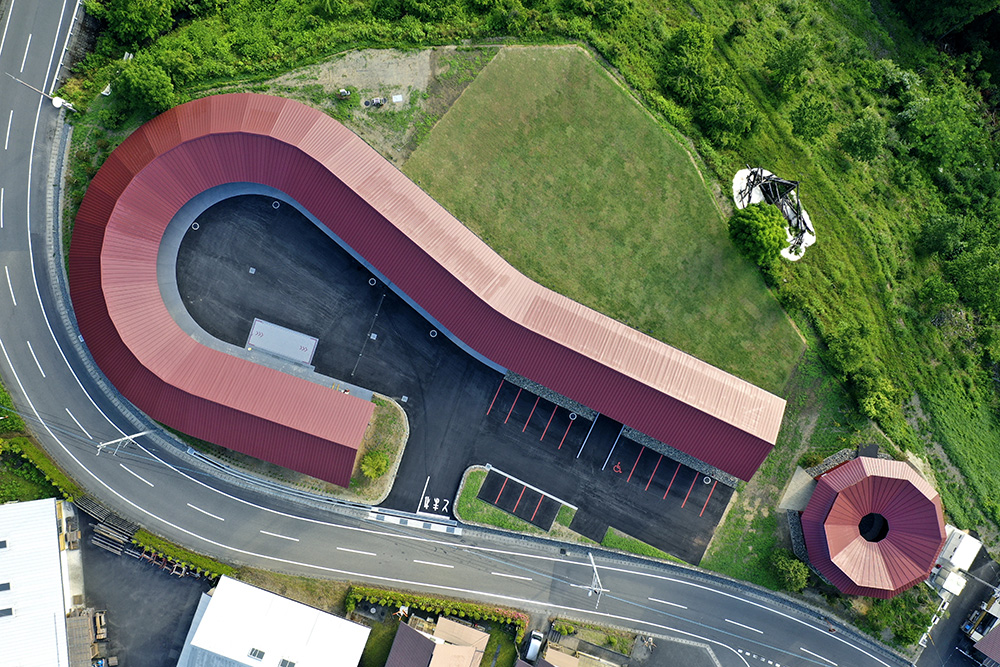
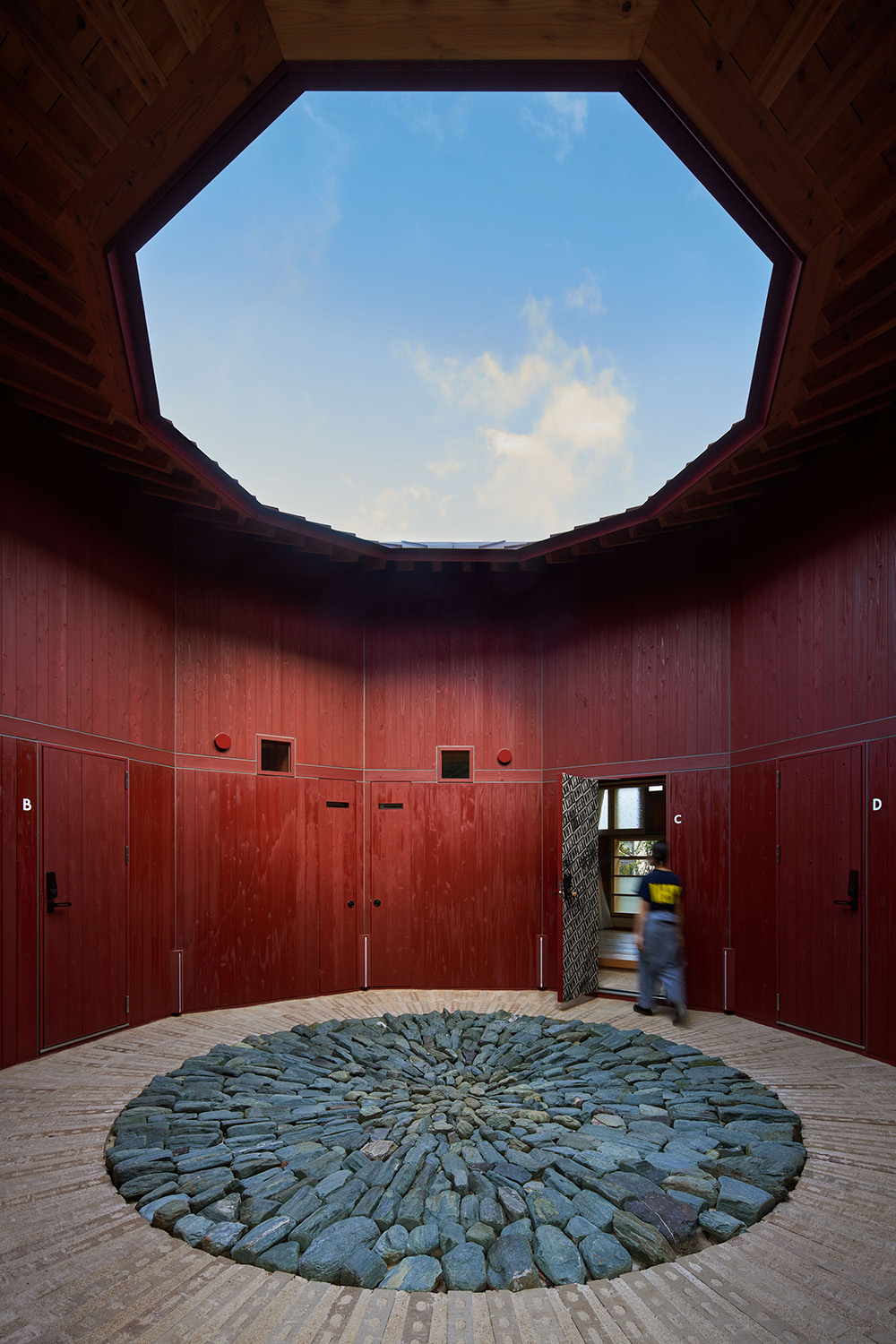
The garden for the lighting of the hotel. The center is made of stones from the Kamikatsu river, and the surrounding area is paved with upright rows of bricks from disposals.
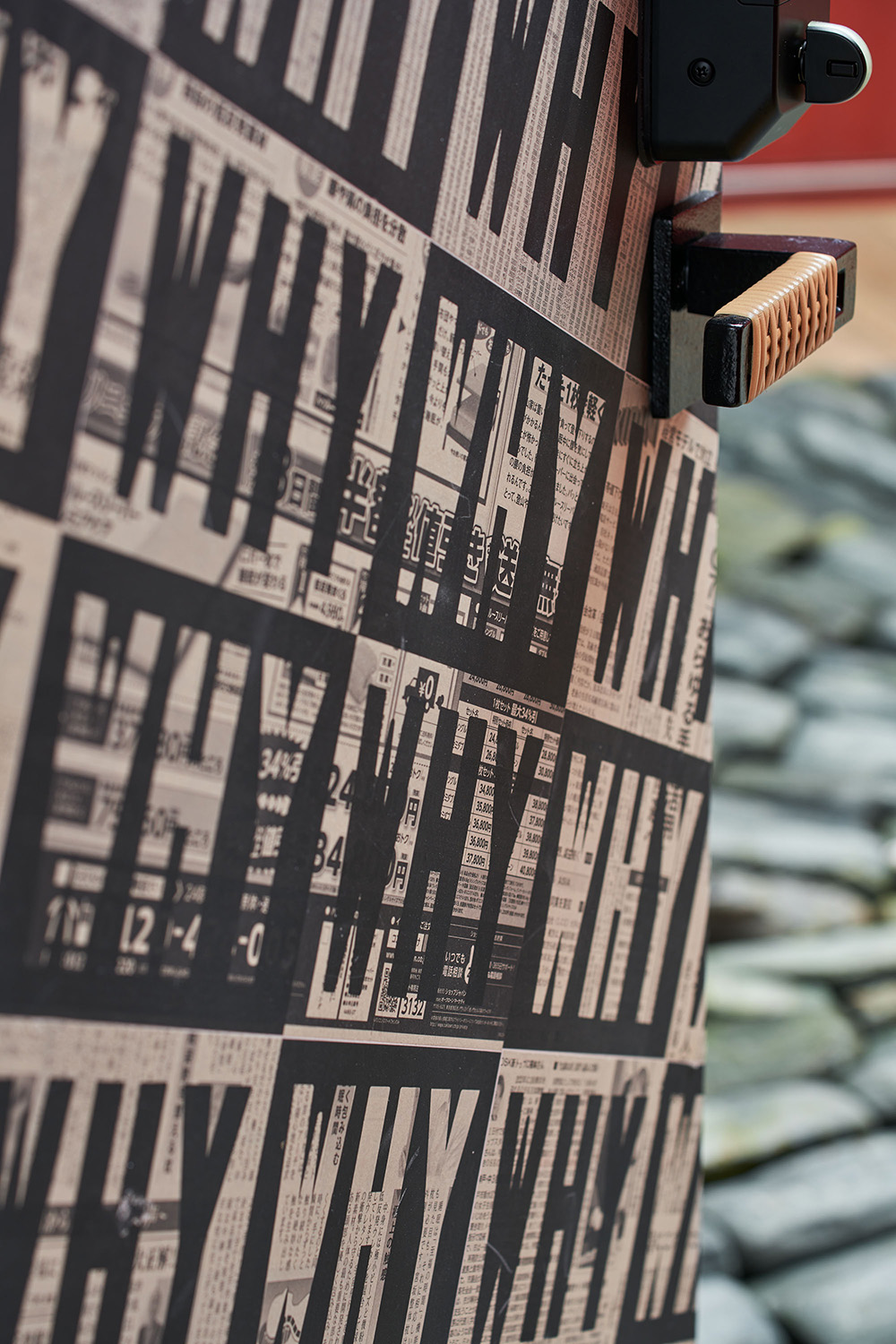
On top of the consumer ads in the newspaper, "Why buy it? Why do we throw it away?" The letters "WHY" were letterpress printed over the newspaper consumer advertisements as wallpaper.
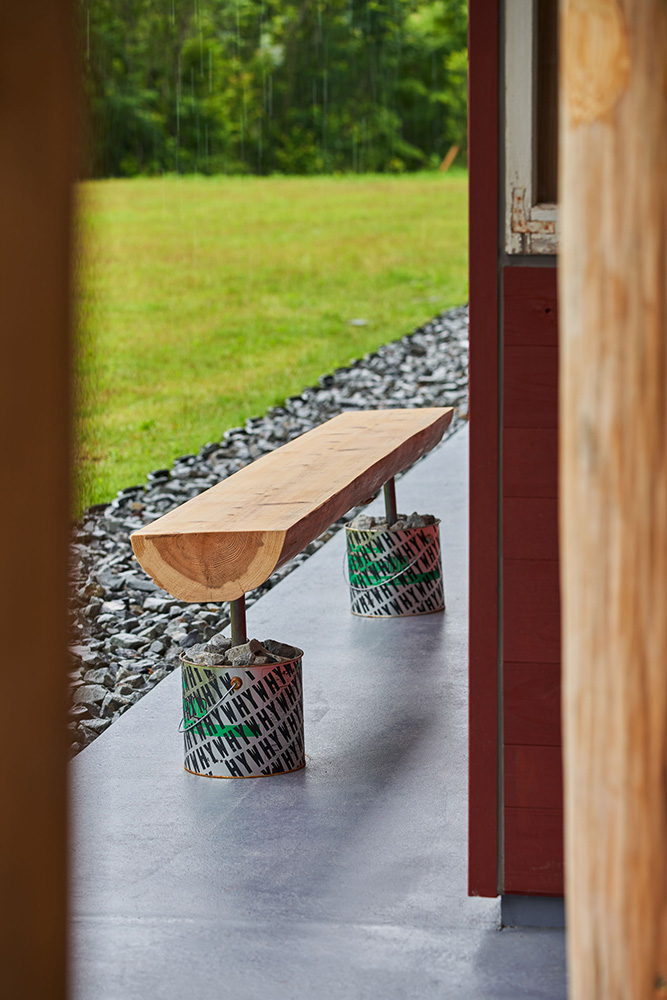
One-paint cans from the construction are being reused for benches.
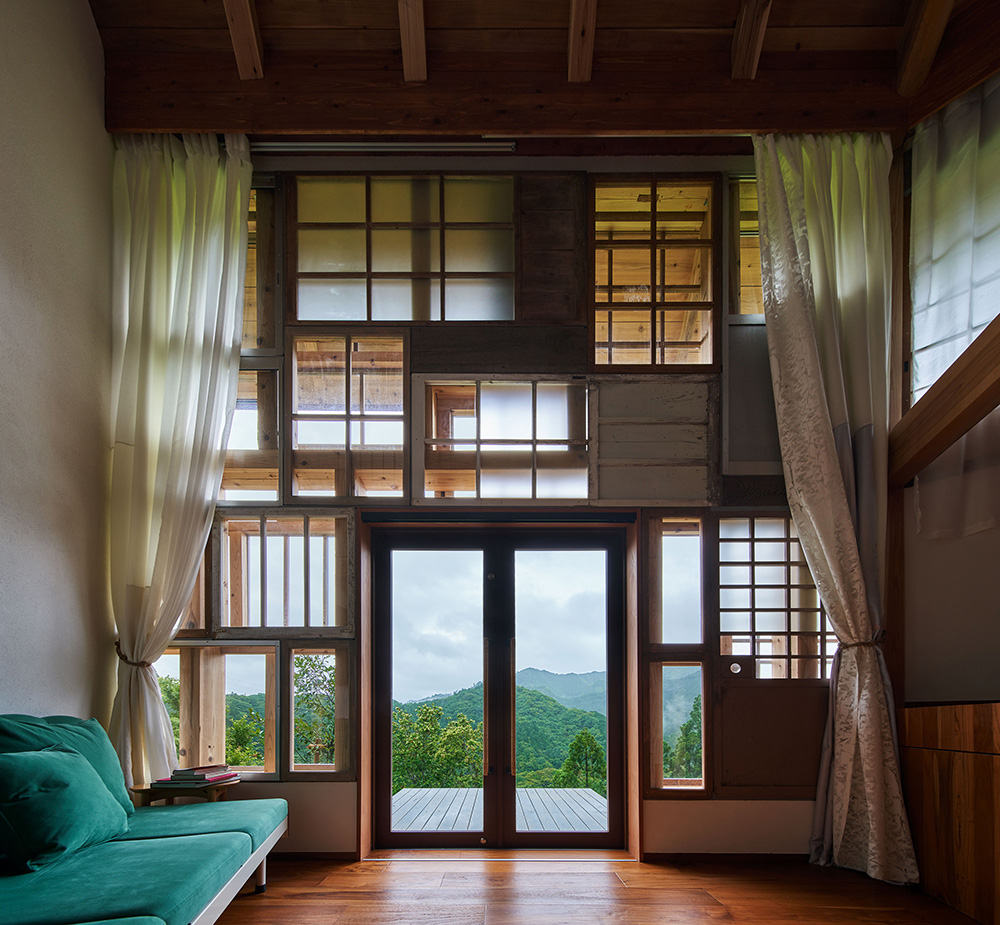
Hotel room. The windows, curtains, sofas, etc. are made from reused materials.
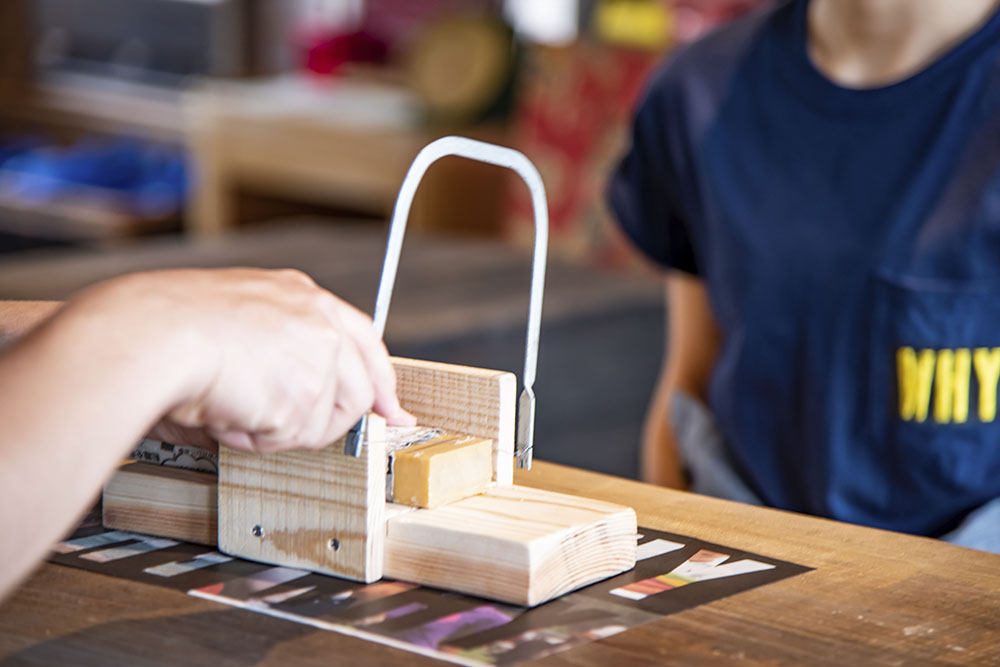
Separate the coffee, tea, and soap from the service into smaller portions for your own use.
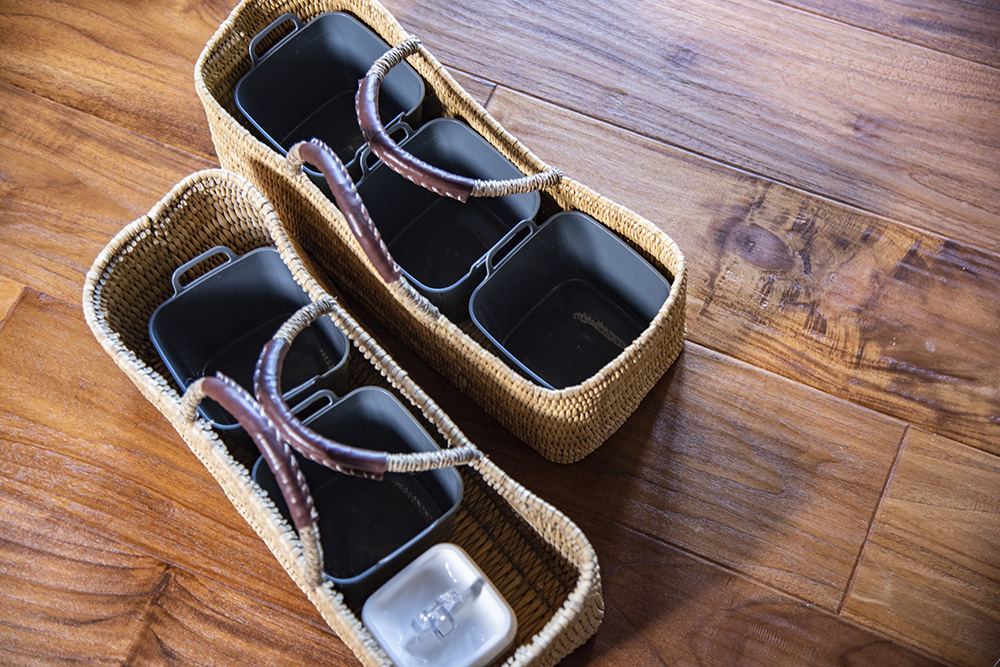
Guests can experience sorting their own garbage during their stay.
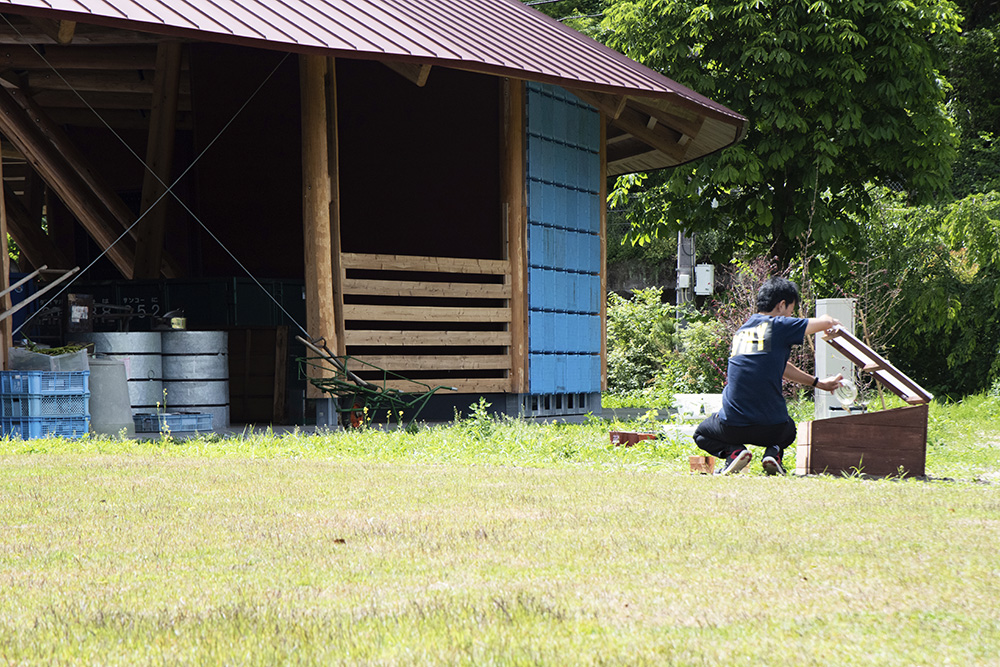
Garbage is composted using a composting system.
When we visit the site, elderly residents will amicably approach us to share, “That was a window at my house,” or “That was a desk at the junior high.” Gazing at the night view of windows in various shapes, it is as if the windows that formerly lit homes have been reunited. We instilled a wish in this architecture to serve as a lantern of hope for the town that struggles with a declining population.
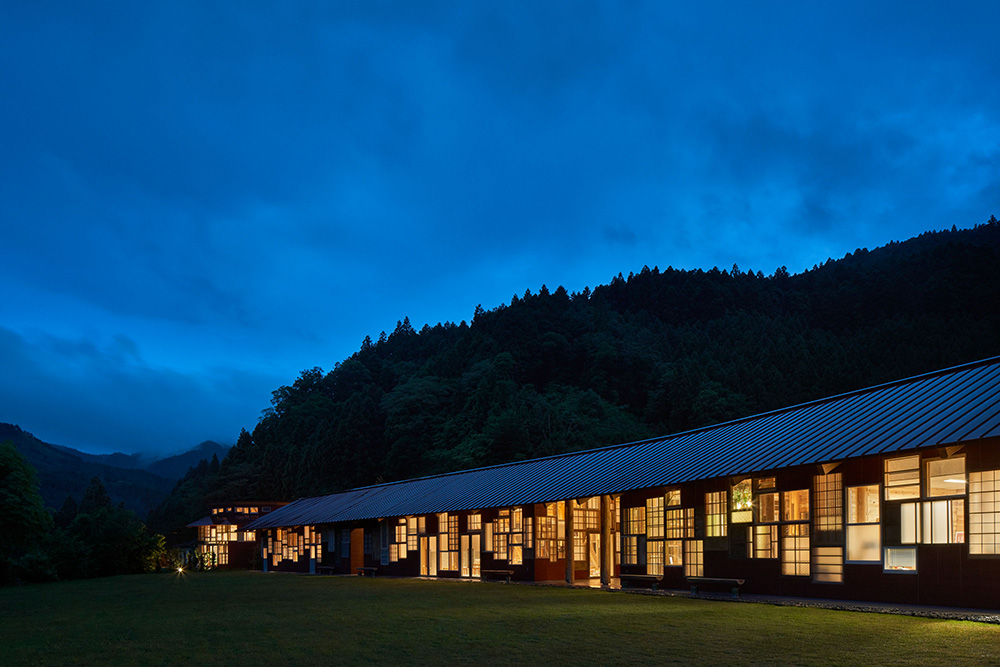
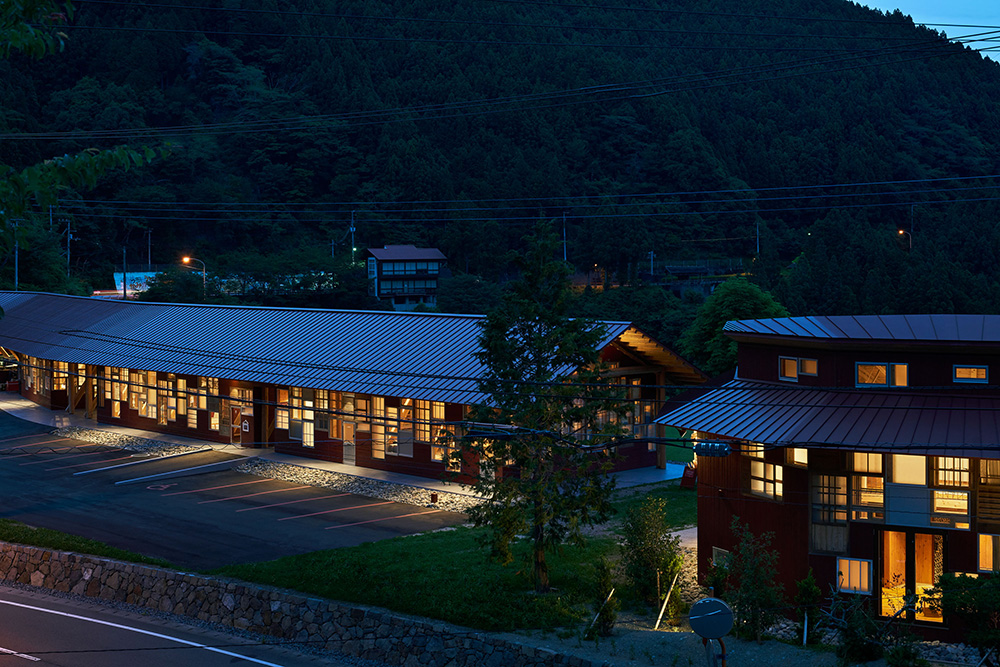
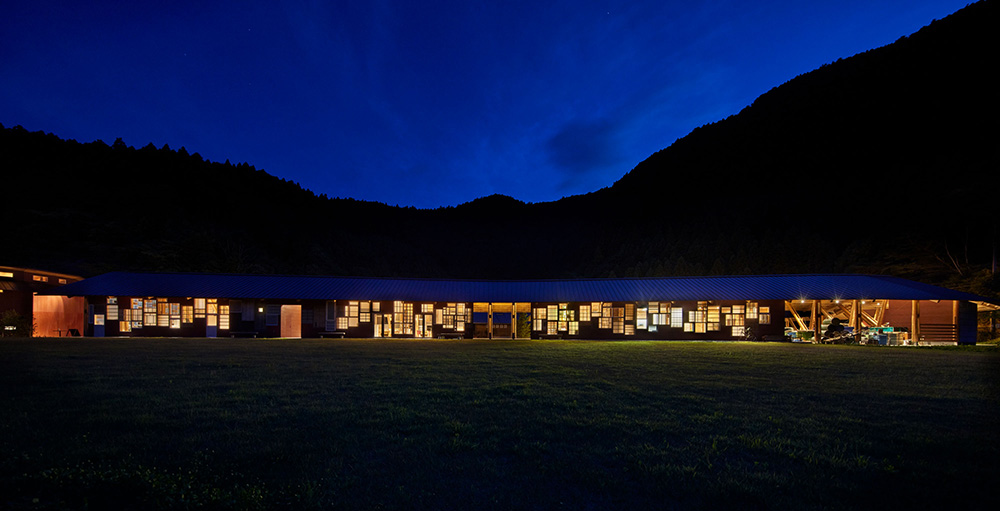
The windows of the houses that used to light the way have been gathered together to form a lantern of hope that illuminates the depopulated town.
- Completion
- 2020.03
- Principal use
- Public Hall
- Structure
- Timber
- Site area
- 5,557m2
- Total floor area
- 1,176m2
- Structure design
- Yamada Noriaki Structural Design Office Co.,Ltd
- Branding, Creative Production and Experience Design
- TRANSIT GENERAL OFFICE
- Contractor
- Kitajima Corporation
- Furniture design & Production
- Wrap architects office
- Team
- Masaki Hirakawa, Masaya Matsushita
- AIJ Prize 2021 Architectural Design Division
- JIA 2021 Environmental Architect
- Dezeen Awards 2021 sustainable building of the year
- Ministry of Internal Affairs and Communications, 2021 Furusato Zukuri Awards, Grand Prize (Kamikatsu, Tokushima)
- KUKAN OF THE YEAR 2022
- KUKAN DESIGN AWARD Sustainable Space of the Year 2022
